
[ad_1]
Vous apprendrez à créer un blog dès aujourd’hui en 6 étapes simples qui prendront environ 10 à 15 minutes. Cliquez ici pour passer directement à l’étape 1 et commencer maintenant.
Suivez ces 6 étapes pour apprendre à créer un blog et à gagner de l’argent dès aujourd’hui:
Divulgation: Veuillez noter que certains des liens ci-dessous sont des liens d’affiliation et sans frais supplémentaires pour vous, je gagnerai une commission. Lorsque vous achetez un hébergement en utilisant mon lien d’affiliation Bluehost, ils me rémunèrent, ce qui contribue à rendre ce guide gratuit pour vous. Sachez que je ne recommande que les produits et services que j’ai personnellement utilisés et que je soutiens.
Qu’est-ce qu’un blog?
Un blog est un site Web régulièrement mis à jour où du nouveau contenu est fréquemment publié, généralement rédigé dans un style informel ou conversationnel, souvent dans le but d’attirer des lecteurs et de générer des revenus en ligne. Vous lisez sur ma blog ici dès maintenant, et ce guide facile à suivre vous guidera tout au long de l’apprentissage de la création de votre propre blog.
Dois-je créer un blog?
Oui! Créer un blog est l’un des moyens les plus simples et les plus accessibles de lancer votre propre entreprise et de gagner un revenu en ligne (de partout dans le monde). Vous n’avez pas besoin d’être un écrivain professionnel ou un développeur Web, et vous n’avez pas besoin d’informations d’identification, d’années d’expérience dans votre domaine ou d’un diplôme pour créer un blog et réussir. Vous pouvez commencer à bloguer quel que soit votre âge, votre emplacement ou votre niveau d’expérience et toujours créer une entreprise en ligne rentable.
Puis-je créer un blog sans aucune expérience technique?
Même si vous n’avez aucune expérience technique avec les sites Web, créer un blog est devenu beaucoup plus facile en 2021. Ce guide a été créé dans un souci de simplicité d’utilisation, et je vous guiderai à chaque étape du processus, afin que vous capable d’apprendre à créer un blog (très facilement) aujourd’hui.
Est-il encore possible de gagner de l’argent avec un blog aujourd’hui?
Oui, des millions de personnes dans le monde se tournent vers le fait de gagner de l’argent à domicile plutôt que de poursuivre un travail traditionnel de 9 à 5. Les blogs peuvent être l’une des entreprises en ligne les plus rentables avec des coûts de démarrage très faibles. Vous n’avez pas non plus besoin de bloguer à plein temps. Même les blogueurs à temps partiel peuvent gagner bien dans les six chiffres de leurs blogs chaque année, comme je le fais depuis de nombreuses années ici. Le démarrage de mon blog (dans le cadre de mon travail quotidien) m’a aidé à créer une entreprise d’écriture indépendante à six chiffres. Finalement, j’ai davantage monétisé en prenant des publicités et des parrainages, en proposant des cours en ligne, en lançant un podcast et plus encore (ce que nous reviendrons plus tard).
Combien cela coûte-t-il de créer un blog en 2021?
En fonction de vos objectifs et du type de blog que vous souhaitez démarrer, il en coûte environ 34,50 $ à 65,40 $ pour démarrer un blog en 2021 et couvrir votre première année de dépenses essentielles (l’hébergement Web sera votre principale dépense). Au fur et à mesure que vous découvrirez comment créer un blog dans ce guide, nous vous expliquerons quels coûts de blogage peuvent être réduits ou éliminés pour vous aider à maintenir un budget serré.
Suivez ces 6 étapes pour apprendre à créer un blog et à gagner de l’argent dès aujourd’hui:
Si vous êtes prêt à franchir le pas et à apprendre à créer un blog qui peut devenir une véritable source de revenus en ligne, alors plongeons-nous.
1. Choisissez le nom et le créneau de votre blog
Tout d’abord, il est temps de choisir un nom et un créneau pour votre nouveau blog.
Le nom de votre blog est ce que les lecteurs verront en premier (comme yourblog.com), il doit donc idéalement représenter soit les sujets généraux sur lesquels vous allez écrire, soit votre propre nom, celui de votre entreprise, une combinaison intelligente de mots ou autre.
Le créneau de votre blog est le sujet général sur lequel vous concentrerez votre contenu. Les exemples incluent des sujets tels que les voyages, la nourriture, la mode, le style de vie, la technologie, etc. Incorporer un mot ou deux qui signale clairement quelle votre contenu porte sur, dans le nom de votre blog (comme fashionbyjane.com ou alors watchryanhike.com) – sera très utile pour vos futurs lecteurs de blog.
Que faire si je ne peux pas encore décider du nom (ou du sujet) d’un blog?
Si vous manquez d’idées sur la façon de nommer votre blog ou sur les sujets sur lesquels vous devriez bloguer en premier lieu (c’est-à-dire votre «niche de blog»), commencez quand même! Si vous êtes comme la majorité d’entre nous, vous trouverez la clarté en agissant et en vous lançant dès aujourd’hui, plutôt que de passer du temps à essayer de trouver le parfait idée. Vous trouverez votre rythme au fur et à mesure que vous progressez.
Que se passe-t-il si le nom que je souhaite utiliser n’est pas disponible?
Lorsque vous démarrez votre blog avec une société d’hébergement telle que Bluehost, celle-ci vous permettra de choisir votre nom de domaine plus tard. Si le nom de domaine que vous voulez n’est pas disponible, ne vous raccrochez pas à ce stade – sélectionnez simplement leur option pour choisir votre nom plus tard après avoir configuré tout le reste et vous aurez plus de temps pour réfléchir (rappelez-vous, l’exécution est ce que tu es là pour, pas pour la perfection).
Puis-je changer le nom de mon blog plus tard?
Oui, vous pouvez facilement changer le nom de votre blog plus tard, il vous suffira d’acheter un nouveau nom de domaine (environ 10 $). Bien que le nom que vous choisissez pour votre blog soit important, c’est quelque chose que vous pouvez toujours changer à l’avenir. Ne laissez pas cette étape vous retenir.
2. Mettez votre blog en ligne (hébergement Web)
La deuxième étape du démarrage d’un blog consiste à mettre votre blog en ligne. C’est ce qu’une société d’hébergement Web fera pour vous. Au cours de cette étape, vous sélectionnerez la plate-forme de blogs et le plan d’hébergement Web que vous utiliserez pour mettre votre blog en ligne.
Qu’est-ce que l’hébergement Web?
Pour rendre votre site Web accessible à d’autres personnes sur Internet, vous avez besoin d’un «hébergeur». L’hébergeur garde tous les fichiers de votre site Web en toute sécurité et s’assure que les gens peuvent accéder à votre blog lorsqu’ils cliquent sur un lien ou saisissent votre URL. Pensez à l’hébergement Web comme à votre maison. Quand quelqu’un vient (saisit l’URL de votre blog), il pourra voir ce qu’il y a à l’intérieur.
Combien coûte l’hébergement Web?
L’hébergement Web est à faible coût (environ 5 $ / mois) avec un fournisseur d’hébergement de haute qualité comme Bluehost. Avoir une société d’hébergement appropriée pour alimenter votre blog est l’un des investissements les plus importants que vous puissiez faire pour commencer.
Quel est le meilleur service d’hébergement Web à utiliser?
Il existe plusieurs excellents fournisseurs d’hébergement Web que vous pouvez utiliser pour héberger votre blog (avec un budget limité). La société que j’ai trouvée qui vérifie le mieux toutes les boîtes à clés (et plus) pour les nouveaux blogueurs est Bluehost. Quel que soit votre choix, vous devriez rechercher une société d’hébergement Web qui donne la priorité à la vitesse, aux fonctionnalités, à la sécurité, au support et à un historique fiable.
La combinaison de la plateforme de blogs et de l’hébergement Web que j’utilise personnellement (et que la plupart des autres blogueurs utilisent) est un blog WordPress, hébergé par Bluehost. WordPress est une plate-forme de publication gratuite qui existe depuis 2003 et qui alimente désormais plus de 60% de tous les blogs sur Internet. Bluehost est l’une des entreprises les plus établies et les plus fiables du secteur de l’hébergement de blogs. C’est cette combinaison que nous utiliserons pour démarrer votre blog. Maintenant, préparons votre hébergement.
-> Cliquez ici pour vous rendre sur Bluehost et cliquez sur le bouton vert « Commencer maintenant »
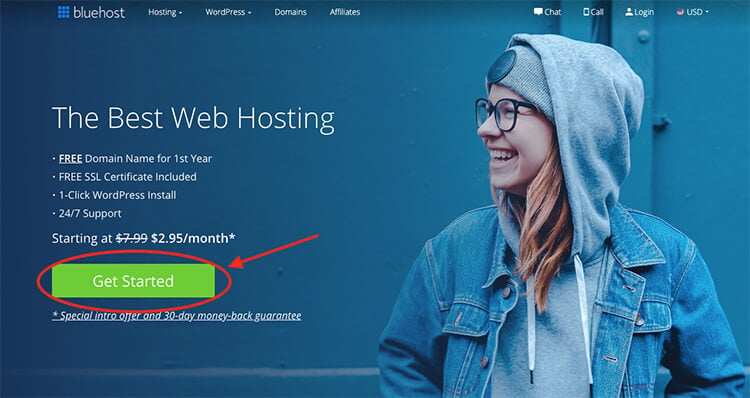
Choisissez votre plan
Tout d’abord, vous sélectionnerez un plan d’hébergement (la saisie du nom de votre blog vient ensuite). Personnellement, je recommande de choisir le Plan Choix Plus car il est livré avec Domain Privacy, qui protégera vos informations personnelles (votre nom complet, votre adresse e-mail, votre numéro de téléphone et votre adresse personnelle) contre la publication en ligne.
Le choix de votre plan ressemblera à ceci ici. Cliquez simplement sur le bouton vert «Sélectionner» sur le plan de votre choix:
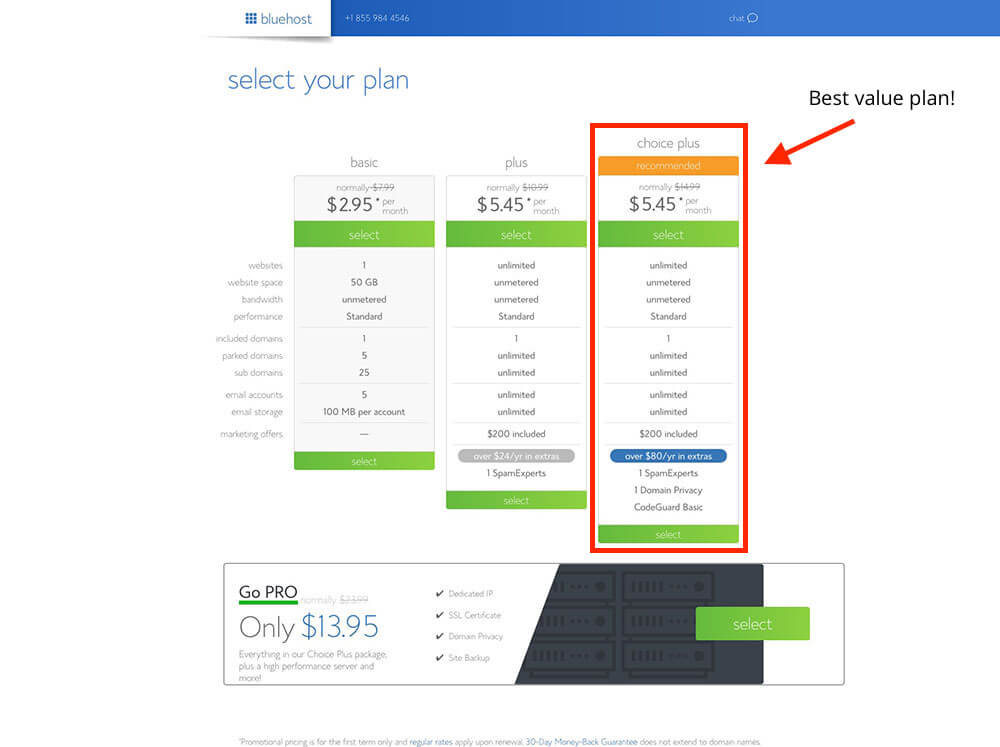
Comme je l’ai dit ci-dessus, je vous recommande de choisir le plan Choice Plus, afin que vous obteniez la fonctionnalité de confidentialité du domaine qui protégera vos informations personnelles en ligne, mais n’importe lequel de ces plans fonctionnera lorsque vous démarrez votre blog – et vous pouvez ajoutez la confidentialité du domaine plus tard pendant le processus de paiement pour environ 1 $ / mois.
Choisissez le nom de domaine de votre blog
Ensuite, vous arriverez à la page où il est temps de choisir le nom de domaine de votre blog:
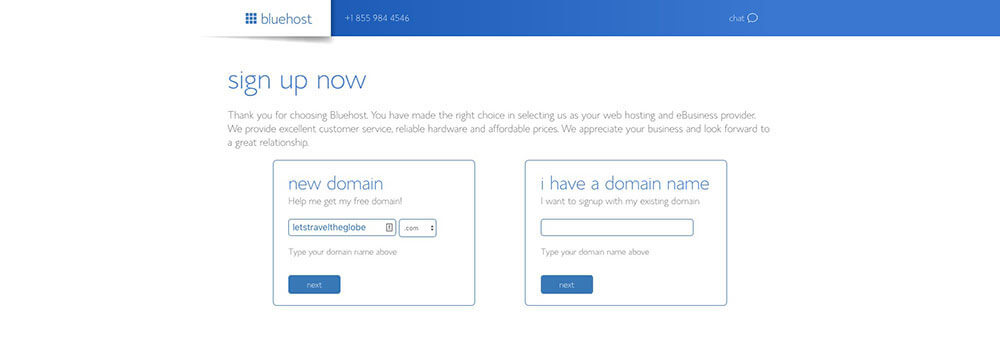
Une fois que vous êtes arrivé à cette étape du processus de paiement, saisissez simplement le nom du domaine que vous souhaitez que votre blog ait (le mien est ryrob.com).
Si vous souhaitez lancer une recherche rapide pour voir si votre nom de domaine est disponible, vous pouvez le faire rapidement ici:
Vérifiez si votre nom de domaine est disponible:
Si le nom de domaine de votre choix n’est pas disponible, vous pouvez soit essayer une autre option qui vous vient à l’esprit, soit (ce que je recommande) sélectionner l’option pour choisissez votre nom de domaine plus tard après avoir réglé le reste de votre compte et avoir pris un peu plus de temps pour réfléchir au nom. De plus, plus loin dans ce guide, j’expliquerai plus en détail comment choisir le bon nom pour votre blog si vous n’êtes pas encore décidé.
Voici où vous pouvez cliquer pour choisir votre domaine plus tard (c’est une fenêtre contextuelle qui apparaîtra si vous passez la souris sur cette page assez longtemps ou si vous déplacez votre souris vers le haut de la page):
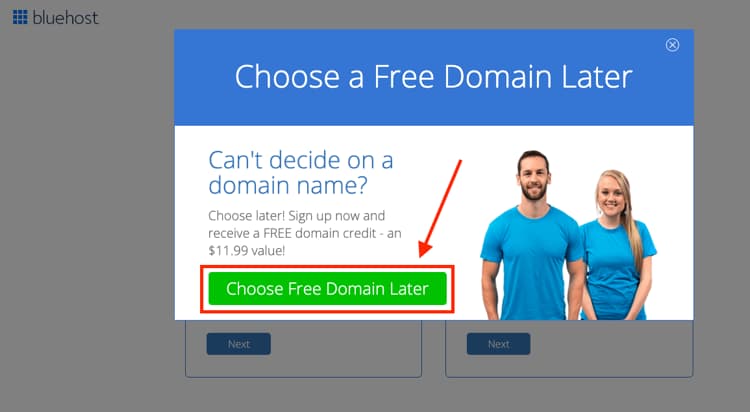
Après avoir choisi votre nom de domaine ou choisi de le sélectionner plus tard, vous serez redirigé vers la dernière étape du processus d’inscription: la création de votre compte.
Créez votre compte Bluehost
Commencez par remplir les détails de votre compte comme votre nom, votre adresse e-mail (il est très important d’utiliser une adresse e-mail à jour car c’est là que vos informations de connexion et vos informations de compte seront envoyées) et votre adresse. Si vous ne souhaitez pas saisir vos informations manuellement, vous pouvez associer votre compte Bluehost à votre compte Google. L’un ou l’autre fonctionne!
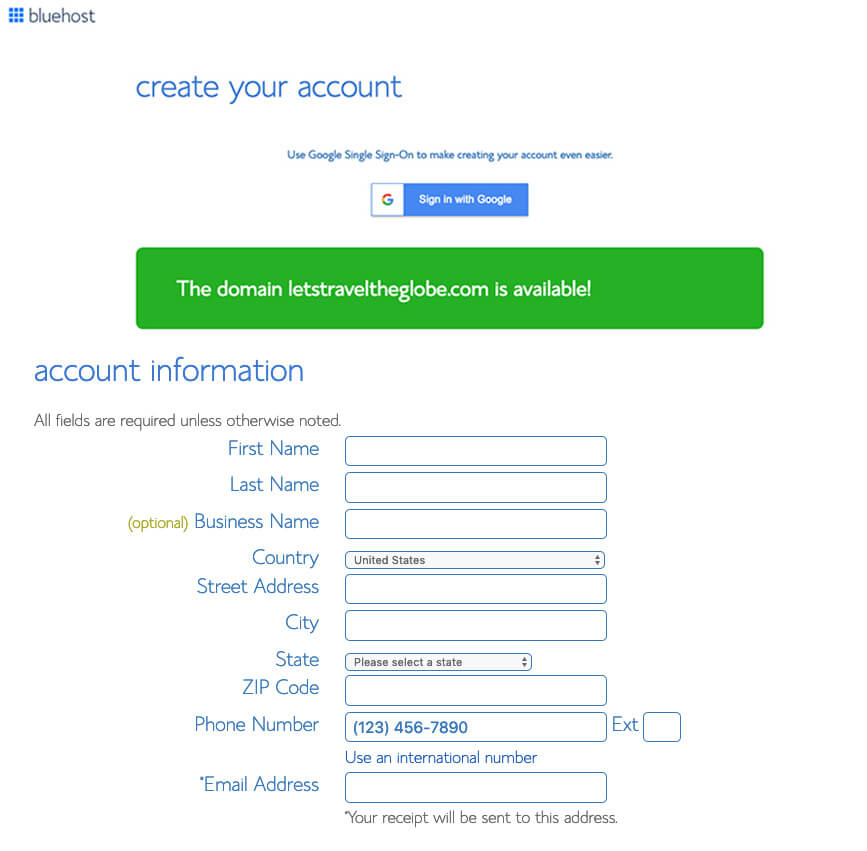
Sélectionnez le bon pack d’hébergement
C’est ici que vous choisirez un plan de compte en fonction du prix que vous souhaitez verrouiller et du délai de paiement à l’avance.

Notez que Bluehost ne propose que des options pour que vous payiez 1, 2, 3 ou 5 ans à l’avance. Ils n’offrent pas d’option de paiement mensuel (car la plupart des sociétés d’hébergement qui proposent des paiements mensuels ont tendance à facturer un peu Suite). Même quand même, quel que soit le plan que vous choisissez, le prix est très avantageux pour créer votre propre blog et le mettre en ligne aujourd’hui.
Avec quel plan tarifaire est-il préférable de créer un blog?
Personnellement, je recommande de choisir le « Prix préférentiel 36 mois » si vous souhaitez verrouiller le prix le plus bas possible pour votre hébergement. C’est ce que j’utilise. Et cela sécurise l’hébergement de votre blog à son taux le plus bas (et vous assure la confidentialité de votre domaine) pour les 3 prochaines années. Et comme ce prix bas pour les nouveaux clients ne s’applique qu’au premier paiement que vous effectuez, si vous deviez choisir le plan d’un an, votre prix mai monter après cette première année.
C’est pourquoi, si vous choisissez le forfait de 36 mois, votre prix sera bloqué à ce tarif pendant 3 ans. Pour cette raison, je vous recommande de choisir le plan de durée la plus longue pour lequel votre budget peut ressortir.
Choisir les bons extras de forfait (ignorer tous sauf un)
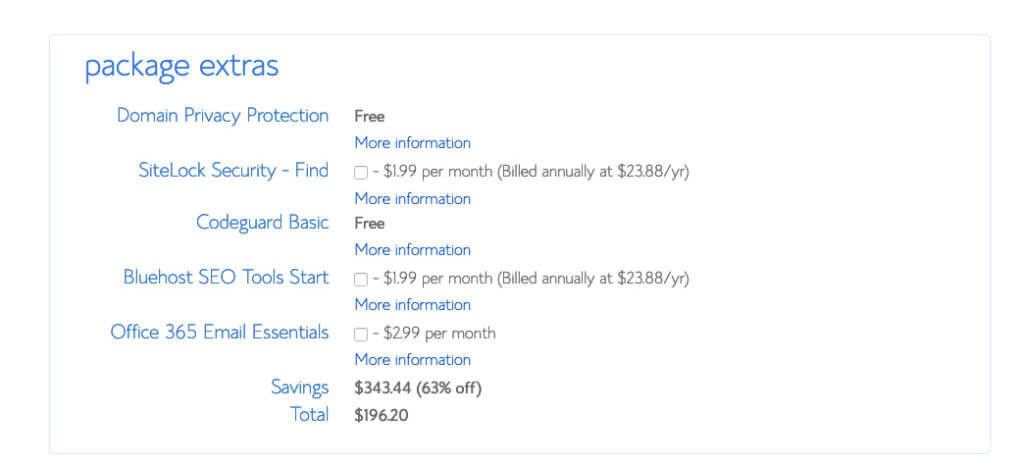
Je recommande de conserver la protection de la confidentialité du domaine en plus, mais vous pouvez vous en passer en sautant le reste. Plus loin dans ce guide, je vous montrerai les nombreux plugins et outils gratuits et bon marché que vous pouvez utiliser pour des choses comme l’optimisation du référencement, la sécurité supplémentaire et les sauvegardes de site, rendant la plupart des autres extras du package inutiles.
Comme je l’ai mentionné plus tôt, le fait d’avoir la confidentialité du domaine supplémentaire garde toutes vos informations de contact personnelles (votre nom, votre e-mail, votre numéro de téléphone et votre adresse) privées. Maintenant, si vous avez choisi le Plan Choix Plus sur l’écran précédent, la protection de la confidentialité de votre domaine sera répertoriée comme « gratuite », comme le montre cette capture d’écran ci-dessus – elle est incluse dans ce plan.
Si vous avez choisi un forfait Basic ou Plus, vous devrez cocher la case pour ajouter la protection de la confidentialité du domaine à votre commande pour environ 1 $ / mois.
Le total que vous verrez maintenant est le montant que vous allez payer aujourd’hui. N’oubliez pas cependant que vous n’aurez pas à payer à nouveau pendant 1, 2, 3 ou 5 ans selon le forfait que vous avez choisi. De plus, il existe une garantie de remboursement de 30 jours au cas où les choses ne se passeraient pas comme prévu avec votre blog.
Entrez vos informations de facturation
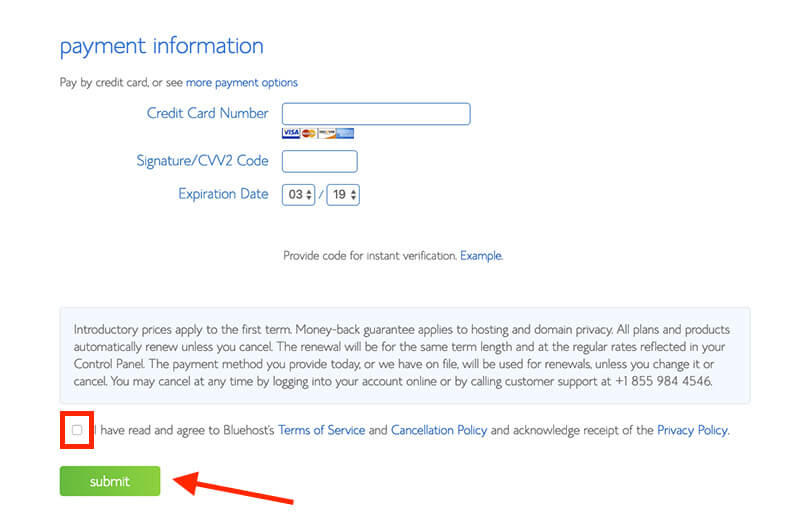
Vous allez maintenant saisir vos informations de facturation, cochez la case indiquant que vous acceptez les conditions d’utilisation de Bluehost, puis cliquez sur le bouton vert «Soumettre».
Courtiser! Il est temps pour une mini fête 🙂
Vous avez officiellement terminé la première étape majeure de la création d’un blog.
Une fois le processus d’inscription initial terminé, il est temps de passer à l’étape suivante pour que votre blog soit entièrement configuré et optimisé.
Sur la page suivante, vous serez guidé étape par étape tout au long du processus d’installation de WordPress sur votre blog via Bluehost – et plus tard dans ce guide, j’ai une tonne de conseils utiles pour optimiser votre blog, gratuitement et des plugins bon marché que vous pouvez installer pour donner à votre blog une belle apparence, et plus encore.
-> Cliquez ici pour vous rendre sur Bluehost et enregistrer votre domaine si vous ne l’avez pas déjà fait.
Désormais, si vous n’avez pas encore configuré votre hébergement Web et que vous souhaitez découvrir d’autres options, il existe d’autres fournisseurs d’hébergement Web qui méritent d’être envisagés.
Les 2 meilleures plates-formes d’hébergement de blogs alternatives à considérer
- Dreamhost – J’ai hébergé des dizaines de sites Web sur Dreamhost au fil des ans (et je le fais toujours). Toutes les fonctionnalités similaires telles que l’installation de WordPress en 1 clic, le certificat SSL gratuit et la sécurité du site mis à part, l’un des plus grands avantages de Dreamhost par rapport aux autres sociétés d’hébergement, c’est qu’ils offrent un véritable plan de paiement par mois qui vous permet de payer pour le coût de l’hébergement de votre blog chaque mois sans aucune condition. Voici quelques autres sociétés d’hébergement Web qui proposent également des plans de paiement mensuel.
- HostGator – Ce qui distingue HostGator des autres sociétés d’hébergement, c’est leur niveau fantastique de support client et le fait qu’ils offrent également un véritable plan de paiement mensuel (ce qui vous aide si vous démarrez votre blog avec un budget limité). HostGator se classe parmi les plus grandes sociétés d’hébergement, alimentant désormais plus de 8 millions de sites Web à travers le monde, ce qui en fait un excellent partenaire pour faire évoluer votre blog au fil du temps.
Si vous souhaitez toujours évaluer davantage les meilleurs fournisseurs d’hébergement de blogs, passez à ma liste des meilleurs plans d’hébergement Web que les blogueurs doivent examiner cette année.
Nous en sommes maintenant au point de ce guide où tout à partir de maintenant sera construit sur l’hypothèse que vous avez déjà enregistré votre nom de domaine et choisi le bon plan d’hébergement – donc si vous ne l’avez pas déjà fait, prenez juste quelques minutes pour le mettre en place rapidement.
Prêt à enregistrer votre nom de domaine et à configurer l’hébergement de blog?
J’ai créé ce didacticiel vidéo détaillé pour vous guider pas à pas tout au long du processus:
Divulgation: Veuillez noter que lorsque vous achetez un hébergement en utilisant mon lien d’affiliation Bluehost, ils me rémunèrent, ce qui m’aide à créer gratuitement ce guide ultime pour démarrer un blog. Sachez que j’utilise également l’hébergement Bluehost et que je ne recommanderais jamais un produit, un outil ou un service que je n’utilise pas personnellement et pour lequel je ne préconise pas 🙂
Je sais de première main que créer un blog sur WordPress peut être un processus intimidant.
Donc, si vous avez besoin de conseils un peu plus détaillés, je mets en place un cours de master gratuit qui répartit tout ce travail dans une série de leçons pleines d’action, et entre encore plus dans les détails que ce didacticiel.
Alors que la première étape cruciale pour démarrer votre blog aujourd’hui est l’enregistrement de votre nom de domaine et la configuration de l’hébergement, mon cours gratuit s’étend à la croissance de votre blog. Tout au long de ce cours de 7 jours, vous passerez de zéro à la publication (et à la promotion) de votre premier article de blog. Je ne peux pas le recommander assez.
Vous voulez mon cours gratuit: Comment démarrer un blog rentable en 7 jours?
Entrez votre nom et votre adresse e-mail et vous aurez un accès instantané à mon cours qui a été présenté sur Forbes, Interne du milieu des affaires et Entrepreneur.
3. Concevez votre blog avec un thème WordPress gratuit

Maintenant que nous avons terminé la phase de configuration cruciale du démarrage d’un blog, il est temps de s’amuser un peu plus.
La conception de votre blog WordPress, c’est quand vous pourriez commencer à ressentir un peu de friction avec ce processus (si vous n’avez jamais travaillé sur un blog auparavant), mais je promets que cela ne deviendra pas trop technique.
De plus… la dernière chose que je veux, c’est pour le très mineur l’aspect technique du démarrage d’un blog pour faire dérailler vos progrès aujourd’hui. C’est pourquoi, dans mon cours gratuit Comment créer un blog en 7 jours, Je décompose ce processus de configuration technique en une liste de contrôle étape par étape encore plus exploitable pour vous.
Si vous souhaitez créer un blog et gagner de l’argent avec celui-ci, WordPress est votre option la plus intelligente
Couvrons quelques termes de base pour que vous compreniez Pourquoi WordPress est la bonne plate-forme (également connue sous le nom de système de gestion de contenu ou CMS) pour exécuter votre blog.
Qu’est-ce qu’un système de gestion de contenu (CMS)?
Un système de gestion de contenu (ou CMS) est l’endroit où vous rédigerez, concevrez et publierez vos articles de blog. Un bon CMS (comme WordPress) est facile à utiliser, vous permet d’organiser votre contenu, de télécharger des images et des vidéos et de contrôler l’apparence de l’ensemble de votre blog à l’aide de thèmes ou d’éléments de conception personnalisés. Le CMS dont vous avez probablement déjà entendu parler est WordPress.
Qu’est-ce que WordPress?
WordPress est le CMS le plus populaire au monde, avec des millions de blogueurs qui l’utilisent chaque jour (moi y compris). En fait, les dernières statistiques de blogs montrent que plus de 60% de tous les blogs fonctionnent sur ce CMS, y compris les sites Web de Forbes, New York Observer, TED, Thought Catalog, TechCrunch, NBC et autres.
Dois-je créer un blog sur WordPress (et WordPress est-il gratuit)?
Bien sûr, il existe d’autres options de CMS que vous pouvez examiner (telles que Wix, Squarespace, Tumblr, Blogger, Medium ou Ghost), mais Je recommande fortement de créer un blog WordPress auto-hébergé car c’est le CMS le plus durable et à long terme. Il est gratuit (vous aurez juste besoin d’un plan d’hébergement Web) et c’est vraiment la seule option à considérer si vous démarrez un blog avec l’objectif final de gagner de l’argent d’une manière, d’une forme ou d’une autre.
Et si je souhaite créer un blog avec Wix à la place?
Bien que je sois un partisan majeur de l’utilisation de WordPress auto-hébergé pour créer un blog (surtout si vous souhaitez maximiser votre capacité à gagner de l’argent avec votre blog sur le long terme), il est toujours possible d’utiliser une plateforme CMS comme Wix pour votre blog à la place. Cependant, l’une des principales considérations à prendre en compte lors de l’utilisation de Wix pour créer un blog, est que vous n’obtiendrez pas l’avantage d’avoir à portée de main le CMS (WordPress) le plus flexible et le plus fonctionnel au monde. Et cette flexibilité est très rentable lorsqu’il s’agit de créer un blog qui peut offrir une expérience formidable à vos futurs lecteurs et vous offrir également le plus d’opportunités de monétiser votre contenu.
Si vous choisissez Wix (ou Squarespace, Tumblr ou Ghost d’ailleurs), les options de personnalisation et de monétisation de votre blog seront considérablement limitées par rapport à toutes les options à votre disposition si vous optez plutôt pour un blog WordPress auto-hébergé où vous garder un contrôle total sur absolument tout. Cela ne veut pas dire qu’il est impossible de créer un blog et de gagner de l’argent avec Wix, mais simplement que vous ne maximisez pas vos opportunités pour le faire.
Depuis que j’ai commencé à bloguer il y a plus de dix ans, je dirige mon blog sur WordPress et je ne pourrais pas être plus satisfait de la flexibilité, du contrôle et du potentiel de croissance à long terme que cette décision m’a procuré.
Maintenant, une chose à laquelle vous devez faire attention, c’est que WordPress est disponible sur deux plates-formes très différentes. Il y a WordPress.com et WordPress.org. Ils ont presque le même nom, mais il y a de très grandes différences entre les deux:
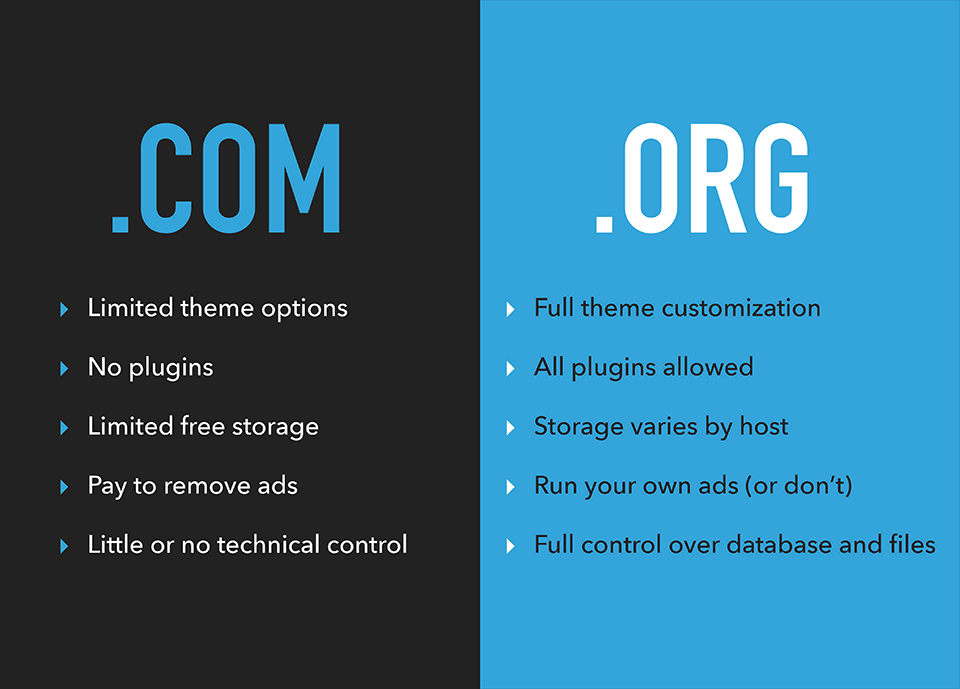
WordPress.com:
- Est libre d’utiliser (avec de lourdes restrictions)
- Ne vous permet pas de choisir un nom de domaine personnalisé (c’est-à-dire 👉 yoursite.wordpress.com)
- Possède des options de monétisation très limitées (vous ne pouvez pas vendre vos propres annonces)
- Ne vous permet pas de télécharger des plugins (pour la capture d’e-mails et autres)
- Prise en charge limitée des thèmes, vous êtes donc coincé avec des conceptions très basiques
- Vous devez payer pour supprimer la marque WordPress et obtenir votre propre domaine comme votresite.com
- SEO et analyses limités
WordPress.org:
- Conception entièrement personnalisable, options de plug-in illimitées et aucune image de marque
- Contrôle total sur vos propres efforts de monétisation
- De puissantes fonctionnalités de référencement (pour que les gens puissent trouver votre site plus facilement)
- Commençons ou ajoutons une boutique de commerce électronique ou un site d’abonnement
- Petits frais mensuels (du plan d’hébergement bon marché que vous utilisez pour mettre votre blog en ligne)
Bien que vous ayez le choix, si vous voulez tirer pleinement parti de votre blog, pouvoir le faire grandir avec vous et éventuellement en tirer de l’argent, WordPress.org est la voie à suivre (et le processus exact que nous avons suivi tout au long. ce guide). C’est le CMS de choix qui restera en arrière-plan et alimentera votre blog.
Comment installer WordPress (et configurer les paramètres de votre blog)
Voici une vidéo pas à pas expliquant comment installer WordPress sur votre nouveau blog et configurer les bons paramètres:
Naturellement, dans cette vidéo, nous ne couvrons pas tout à propos de WordPress, mais rappelez-vous que ce sont les bases que vous devez accomplir premier.
Passez du temps à vous familiariser avec la zone d’administration de votre blog WordPress. Vous développerez une compréhension beaucoup plus approfondie du fonctionnement de WordPress et des éléments que vous pouvez rapidement modifier dans l’apparence visuelle et les fonctionnalités de votre site au fil du temps.
Choisir le meilleur thème WordPress (gratuit)
Lorsque vous êtes encore nouveau dans le démarrage d’un blog, je ne recommande généralement pas d’acheter un thème WordPress payant tout de suite. Une fois que vous avez du trafic et que vous pouvez justifier l’investissement, il est judicieux de choisir un thème premium avec plus de fonctionnalités et d’options. Pour le moment, cependant, un thème complexe détournera l’attention de votre priorité la plus importante qui consiste à attirer les lecteurs sur votre nouveau blog.
WordPress est livré avec une tonne de thèmes gratuits parmi lesquels choisir, alors commencez par l’une des options que vous aimez Apparence> Thèmes> Ajouter un nouveau thème> Populaire sans passer beaucoup de temps là-dessus pour le moment. Vous pouvez toujours revenir et le modifier plus tard.
Je recommande de choisir Kadence WP, Hello Elementor ou Astra (qui sont tous 100% gratuits, rapides et peuvent être mis à niveau plus tard).
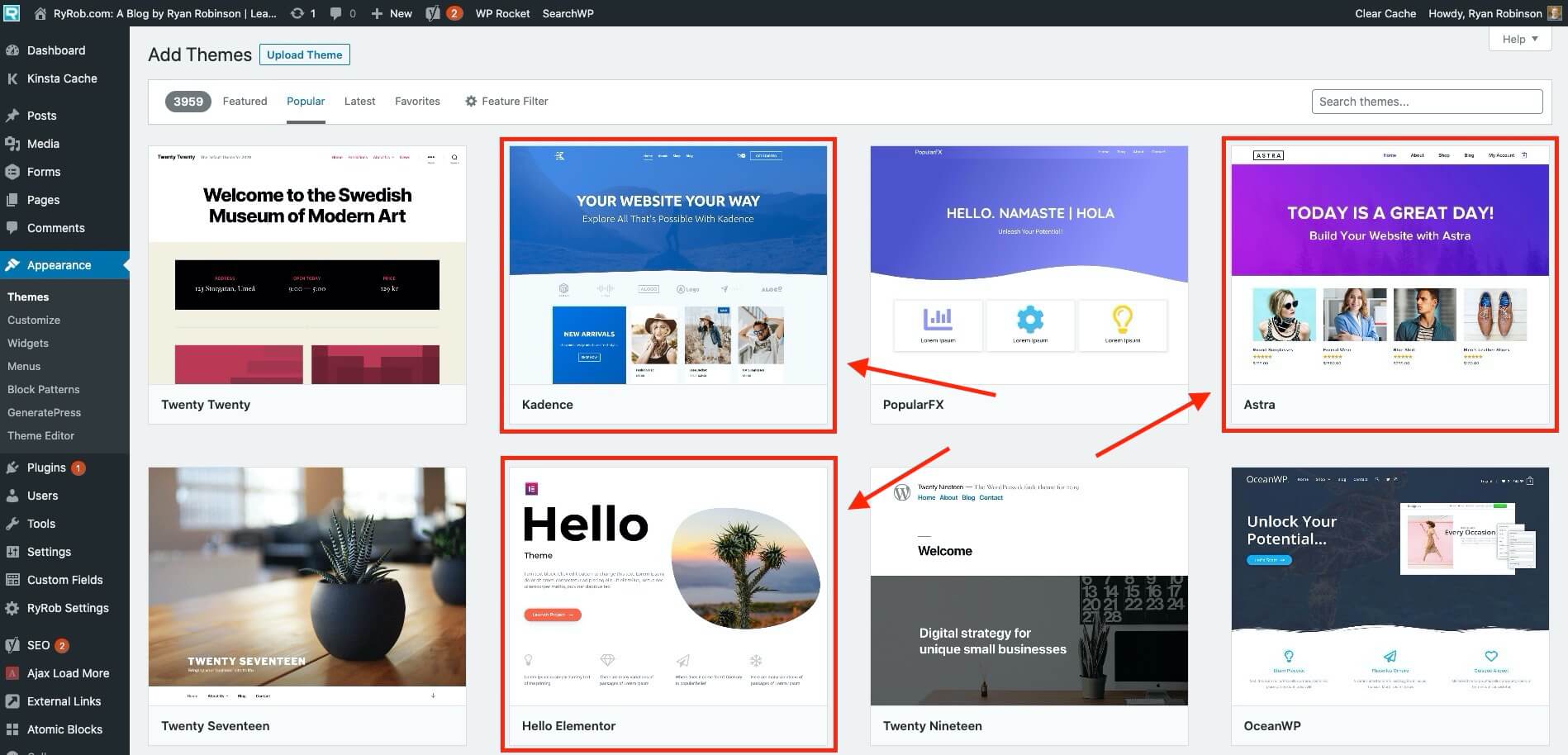
J’aime le plus ces trois thèmes WordPress rapides car ils sont nets, propres, simples et vous permettront de vous configurer sans avoir à investir dans un thème payant lorsque vous venez de démarrer votre blog. Plus tard, vous pouvez évaluer davantage d’autres thèmes WordPress ou mettre à niveau ceux-ci vers leurs versions premium pour plus de fonctionnalités.
Et si je veux choisir un autre thème WordPress (ou changer plus tard)?
Si vous souhaitez expérimenter différents thèmes WordPress pour démarrer un blog, assurez-vous d’utiliser ces critères pour guider vos décisions:
- Utilisation simple: De nombreux thèmes fantaisistes vont au-delà et font des compromis sur la convivialité.
- Sensible: La réactivité fait référence aux thèmes qui garantissent que votre blog a l’air bien sur un ordinateur portable, un smartphone et une tablette. De plus en plus de personnes utilisent leur téléphone pour lire des blogs et Google favorise également les sites Web adaptés aux mobiles. Si vous n’êtes pas sûr qu’un thème soit adapté aux mobiles ou non, copiez et collez l’URL de la page de démonstration du thème dans la page de test de Google Mobile Friendly.
- Prend en charge les plugins: La vraie puissance de votre blog WordPress vient des plugins. Assurez-vous que votre thème prend en charge tous les plugins populaires.
- Convivialité SEO: Le référencement, ou optimisation des moteurs de recherche, fait référence à la capacité de Google et d’autres moteurs de recherche à trouver vos informations lorsque les gens les recherchent. Certains thèmes utilisent un code volumineux qui rend la lecture difficile pour les moteurs de recherche.
- Support: Des problèmes surviennent, et quand ils surviennent, vous voulez pouvoir demander de l’aide. Certains développeurs de thèmes gratuits n’offrent pas d’assistance pour leurs produits, alors gardez cela à l’esprit.
- Notes et avis: Recherchez des thèmes avec de bons antécédents et un historique de notes positives.
Pourquoi le design est si important lors du démarrage d’un blog
Même si vous ne vous souciez pas vraiment du design vous-même, vos lecteurs changeront radicalement leur comportement en fonction des fonctionnalités de la mise en page de votre blog. En fait, lors d’une étude menée en 2012 par Google et l’Université de Bâle, les chercheurs ont constaté que les utilisateurs jugent la beauté esthétique et la fonctionnalité perçue d’un site Web en 1 / 20e – 1 / 50e de seconde. De plus, grâce à un petit biais psychologique appelé l’effet Halo, les gens étendront ce jugement à tous les aspects de votre blog.
Une bonne conception de blog renforce la confiance. Cela dit aux gens que vous vous souciez suffisamment de votre blog pour le rendre joli. Cela ne signifie pas que vous ayez besoin d’animations folles ou de tonnes de polices et de couleurs. En fait, les meilleurs designs sont simples, clairs et faciles à lire.
Une fois que vous avez choisi le bon thème pour votre blog WordPress, il est temps de plonger dans le monde des plugins WordPress, pour aider à débloquer encore plus de personnalisations et de préparation afin de donner à votre blog une chance de se développer en une véritable entreprise.
7 plugins WordPress essentiels que vous devriez installer sur votre blog aujourd’hui
Les plugins WordPress jouent un rôle crucial dans le fonctionnement de votre blog, et obtenir les plugins les plus essentiels connectés le plus rapidement possible est une étape majeure conçue pour servir à la fois votre public et bien fonctionner pour les moteurs de recherche.
Qu’est-ce qu’un plugin WordPress et pourquoi sont-ils importants?
Un plugin WordPress est un petit logiciel qui peut être considéré comme un «add-on» qui donne des fonctionnalités ou des fonctionnalités supplémentaires à votre blog. Les plugins vous permettent d’ajouter toutes sortes de fonctionnalités, de la collecte des abonnés aux e-mails, au référencement de votre blog, au suivi de l’analyse de votre site Web, à l’optimisation de vos images, à l’augmentation de la vitesse de chargement de vos pages et plus encore.
Le seul problème avec les plugins WordPress, c’est qu’il existe littéralement des milliers de plugins et d’outils de blogs différents parmi lesquels choisir. Pour vous aider à réduire tout le bruit … ce sont les plugins WordPress incontournables à installer lorsque vous commencez à bloguer aujourd’hui:
- Yoast SEO: Plus il y a de personnes qui peuvent trouver votre contenu, meilleur sera votre blog. Le plugin Yoast WordPress vous aide à optimiser les titres de vos articles de blog, les descriptions, la longueur du contenu et d’autres éléments sur l’ensemble de votre blog afin que vous puissiez être trouvé plus facilement par les moteurs de recherche.
- WPForms: Vous souhaiterez que vos lecteurs puissent vous contacter facilement, ce que je recommande vivement, car cela encouragera les autres blogueurs qui souhaitent collaborer avec vous à avoir une opportunité facile de vous contacter. WPForms est un plugin facile à utiliser qui vous permet de glisser-déposer des formulaires de contact sur n’importe quelle page de votre blog.
- Tableau de bord Google Analytics pour WordPress: Il s’agit d’un plugin Google Analytics 100% gratuit qui vous permet de voir toutes vos données analytiques pertinentes directement dans WordPress. Connectez le plug-in à votre compte Google Analytics (vous pouvez créer un compte Google Analytics gratuit ici) pour savoir qui vient sur votre site, combien de temps ils restent et quels sont vos articles de blog les plus populaires.
- UpdraftPlus: Encore une fois, les choses vont parfois mal tourner sur votre blog (et cela ne sera pas toujours totalement sous votre contrôle). Il est toujours judicieux d’avoir un plug-in de sauvegarde qui vous permettra d’économiser régulièrement tout votre travail acharné, et celui-ci gratuit est bien au-dessus des autres.
- WP Rocket: Les sites Web plus rapides se classent mieux dans Google et offrent à vos lecteurs une meilleure expérience. WP Rocket est un plugin qui met en cache vos pages, réduit la taille de vos fichiers et fait bien plus pour que votre blog se charge plus rapidement pour tout le monde.
- MaxCDN: En parlant de vitesse, MaxCDN accélère également le chargement des images et d’autres éléments statiques de votre blog, ce qui lui confère les meilleures notes à considérer comme un complément à l’utilisation de WP Rocket.
- Insérer des en-têtes et des pieds de page: Parfois, pour modifier votre thème, vous devrez ajouter des extraits de code à votre en-tête ou pied de page (ce n’est pas aussi effrayant que cela puisse paraître). Cependant, le faire dans le code de votre thème peut causer des problèmes. Ce plugin vous permet d’ajouter facilement de petits extraits de code pour sélectionner des emplacements autour de votre blog.
- Bonus – Accordéon léger: Si vous aimez la façon dont je crée les boîtes de contenu pliables (de style accordéon) ici tout au long de ce guide et dans la section FAQ au bas de cet article, alors je vous recommande d’installer le plugin gratuit que j’utilise pour donner vie à ces sections de contenu : Accordéon léger. En quelques clics avec ce plugin, vous pouvez rapidement ajouter une fonctionnalité de boîte FAQ réductible à votre blog WordPress.
Les paramètres de base du blog WordPress pour se familiariser maintenant
Il existe de nombreuses raisons différentes pour créer un blog et autant d’objectifs uniques que vous pouvez avoir en tête. Quoi qu’il en soit, il est avantageux d’avoir une compréhension de base des aspects plus larges du fonctionnement de WordPress, afin de pouvoir contrôler l’apparence visuelle de votre blog.
Examinons quelques-uns des paramètres plus larges que vous pouvez trouver dans votre tableau de bord WordPress.
Permaliens (URL)
Comment optimiser vos paramètres de permalien WordPress (cliquez pour agrandir)
Nous en avons parlé dans ma vidéo de présentation (ci-dessus), lorsque j’ai personnalisé l’URL du premier article de blog que j’ai publié. Et lorsque vous configurez votre blog WordPress à l’aide de Bluehost, les paramètres de lien permanent seront déjà optimisés par défaut pour publier de nouveaux articles de blog au format de domain.com/post-name (comme vous l’avez vu dans la vidéo).
Si vos paramètres de lien permanent ne sont pas déjà définis sur ce format, il est important de les modifier dès maintenant. Cela vous aidera à mieux vous classer dans les moteurs de recherche comme Google, car le texte de votre titre apparaîtra dans chacune de vos URL.
Dans votre tableau de bord WordPress, passez la souris sur « Paramètres » et accédez à Paramètres> Permaliens pour effectuer cet ajustement. Cela devrait ressembler à ceci ici:

Vous pourrez toujours personnaliser l’URL d’un article avant de le publier dans WordPress, mais vous disposez désormais d’une structure d’URL par défaut qui est conviviale pour le référencement. Consultez mon guide sur la création de permaliens compatibles avec le référencement pour en savoir plus.
Nettoyer l’URL de votre site par défaut
Comment nettoyer l’URL de votre site par défaut (cliquez pour développer)
Une fois votre thème WordPress installé, vous souhaiterez modifier l’URL par défaut de votre site Web pour inclure un « www« Avant l’URL de votre site.
Cela vous amènera à partir d’une URL qui ressemble à https://yourblogname.com à un plus attrayant visuellement https://www.yourblogname.com.
Vous pouvez changer cela rapidement en accédant à Paramètres> Général et suite à cette action:

Toutes les pages de votre blog seront désormais automatiquement redirigées vers le www version, qui semble beaucoup plus propre et a tendance à se sentir plus digne de confiance pour les lecteurs.
Définition de la page d’accueil de votre blog
Comment définir la page d’accueil de votre blog (cliquez pour développer)
As I recommend in the tutorial video above, my advice is to just set your homepage to be where your blog posts display (for now) as you’re just starting your blog.
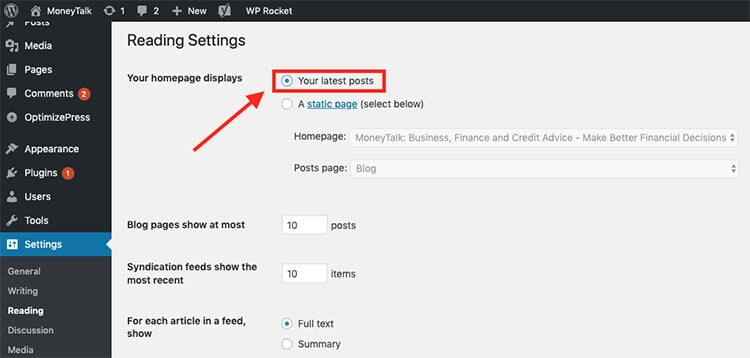
You have the option of setting your homepage to be a static, custom designed page that can serve to capture email sign ups, sell a product, or otherwise in the future. But for now, stick with just a list of your recent blog posts as you still navigate the process of learning how to blog.
If you’re setting your homepage to be the blog, then one thing you can consider is changing the settings to show the complete text of your blog posts right on the homepage, rather than a list that has short previews of each post.
Since you won’t have many posts on your new WordPress blog for the next few days or weeks, this’ll make it look like there’s more content in the short-term, and you can change the settings back to a list and preview format once you’ve gotten your first 5 or so posts published.
To change these settings, just go to Settings > Reading.
Setting up your blog’s menu
How to set up a menu on your WordPress blog (click to expand)
When you first start your blog, you won’t quite need a menu until you’ve published your key pages (About, Contact, Hire, Shop, etc), but when you’re ready to create a homepage or footer menu, just go to Appearance > Menus and you can create them in just a few clicks.
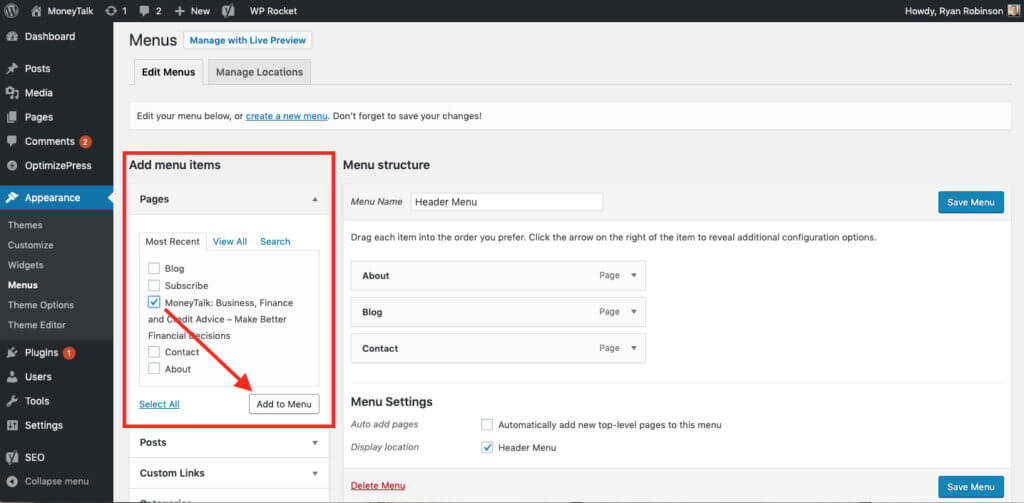
Alright, we’ve covered the basic foundations of getting your blog’s WordPress settings dialed in. Now, let’s dig into creating a few of the main pages on your blog.
Creating the main pages of your blog (about, contact, hire)
From the moment you start a blog, you’ll want to showcase some basic information about yourself. Who you are. Why people should listen to you. How they can get in touch with you if they have questions or want to work with you.
These pages are all pretty standard, but they’re also a great way to have some fun and let your readers get to know you. In fact, I use my own About page to not only introduce who I am and tell my story, but also to explain my value proposition (for potential clients looking to hire me as a freelance content marketer) and show recent achievements.
Here are step-by-step instructions for how to write an About Me page that does this on your blog, too:
How to write an About page for your blog
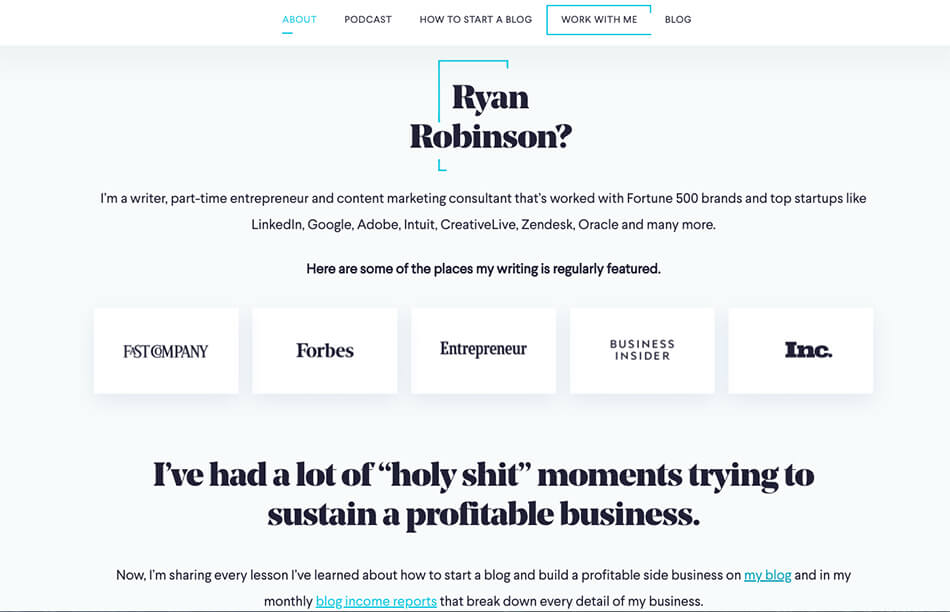
You might not think much about it, but your About page can quickly become one of the most popular pages on your blog.
How to write your blog’s about page (click to expand)
Writing about yourself isn’t easy. So let’s start with a few basic questions that every great blog About page should answer:
1. What value are you creating for your readers?
It might be called an About page, but you don’t want to make the mistake of only talking about yourself. Yes, you’ll get to talk about who you are, but your About page should be just as much about your readers and the value you’re creating for them. Be clear on who your audience is, the value you create for them and answer why you chose to start a blog for them.
For example, my blog is all about helping people grow their blogs today, finding the best business ideas and launching profitable side projects. So, that’s exactly what I say at the top of my About page. This helps readers know that they’re in the right place.
2. Who is your blog for?
Your value statement will touch on who your ideal reader is, but you want to make sure when the right person gets to your blog they know they’re in the right place. There are a couple approaches you can take to communicate this:
- Tell them who your blog is for: There’s nothing more basic than just saying who you are. So, for example, if you’re starting a blog on WordPress to create a community around cooking tips for working moms, just write: “Started in 2021 as a cooking resource for working moms.”
- Show proof that you’re part of their community: You can show your readers that you’re part of their community in a number of ways. Do you write for other blogs or sites that are in your niche or actively contribute to popular communities and forums? What about adding a testimonial or social post from someone in the industry who read and liked your blog.
If you have the ability to show your contributions to the broader community you’re blogging in, this is your chance to highlight it. Not only does this tell readers who you are, but you can also show social proof (that other people have recognized you as a thought leader).

Now, what if someone reads your About page and says “Well, this isn’t for me?” That’s perfectly fine. The more you know your ideal reader, the better your blog will serve that person.
3. Why should they listen to you?
If you’ve done a good job in the first few sections, your reader should have a pretty good idea of who you are and be able to decide whether or not they want to keep reading you. It doesn’t hurt to talk a bit more about yourself and sell them on why you’re the blog they should follow. Here are a few more ideas you can include:
- What types of blog posts you write: “If you love X, Y, and Z, you’ll feel totally at home here.”
- What they will get out of reading your posts: « I share everything I’ve learned building a 6-figure consulting business from nothing.”
- Where should they start: “If this is your first time here, check out my Ultimate Guide to X.”
- Why do you and your blog have credibility: « I’m a regular contributor to Fast Company, Business Insider, and Inc. Magazine…”
- How did you get started: « Back is 2003, during an especially bad Colorado Winter, I fell in love with snowshoeing…”
Don’t be afraid to get personal. People connect with stories and vulnerability more than they do with carefully crafted prose. The reason readers will come back, is to hear your voice.
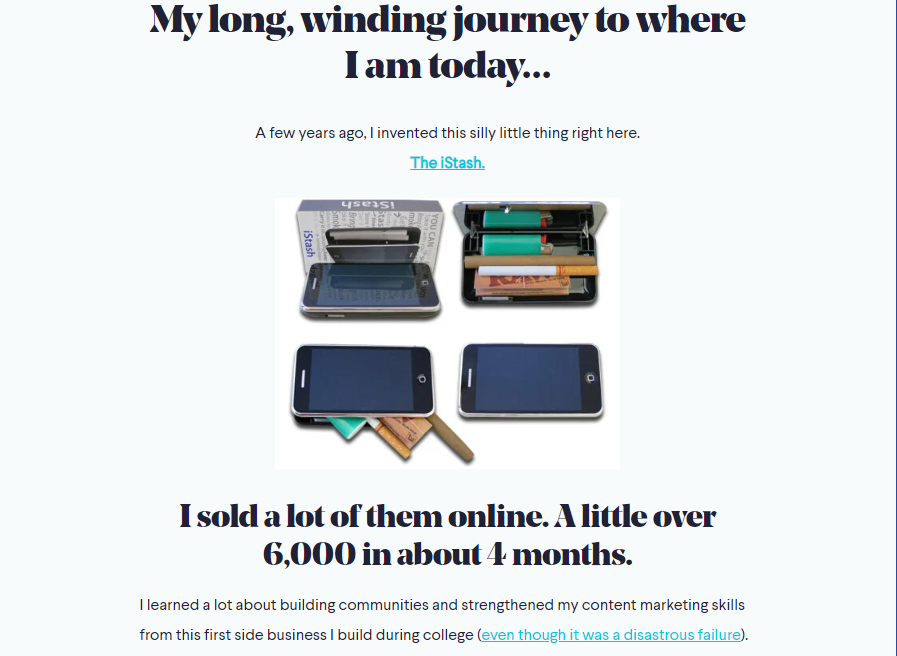
For my niche, I know my readers are here to get personal, actionable advice on starting a side business.
4. Where should your readers go next?
The last (and probably most important) part of your About page is also the one that most people forget about. Telling your readers what to do next! Do you want them to read your latest blog post? Sign up for your newsletter? Follow you on Twitter? If someone has made it all the way to the bottom of your page, why leave them alone now?
I know that if someone’s made it to my blog’s About page, they probably just met me. Which means I don’t want to ask anything too taxing like signing up for a newsletter or following me on social media. Instead, I want them to get to know me better, so they can do that on their own. That’s why my Call-to-Action (CTA) is to simply read my best content.
Use your about page to show the value you’re creating for your readers—and work hard to earn that attention.
How to write a Contact page for your blog
Another often overlooked page that you’ll want to include early on when you start a blog, is a simple way for people to contact you.
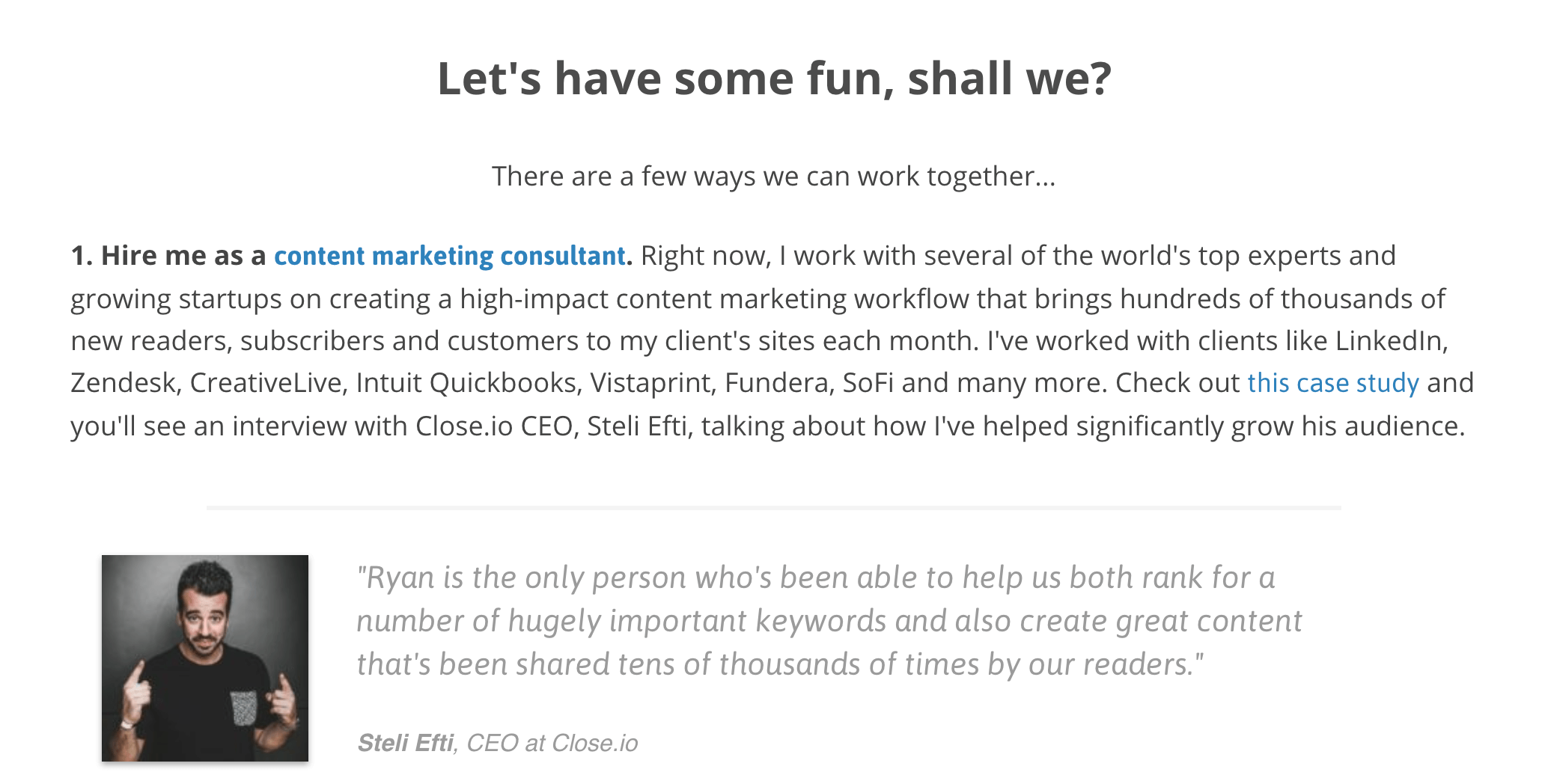
While mine goes into more depth, your Contact page can be as simple as having your email and social media accounts listed on a page.
How to create a contact page for your blog (click to expand)
If you’ve chosen to start a blog on WordPress, one of the best ways to do this is to use a form plugin like WP Forms, which lets you create custom contact forms just by dragging and dropping elements.
When you’re making your blog’s Contact page, it’s not enough to just put up the form, however. Think about why someone would want to get in touch with you. Can you answer basic questions upfront with an FAQ on your contact page?
Draw on your purpose as a blogger when writing your contact page. For my blog, I know that people reading it might want to hire me to help them with their own content marketing. Which is why I’ve chosen to make my Contact page more focused around the topic of how to “Work with Me”. This page says exactly what I do, who I’m looking to work with and gives opportunities for people to get in touch.
Think about what types of communication you want from your readers, and use your Contact page to set those expectations right away.
New to Starting a Blog with WordPress? Check Out These Technical Tutorials
If you’re starting a blog on WordPress and want to spend a little more time tuning things up & experimenting with all of your settings, then check out these quick WordPress tutorials:
Want my Free Course: How to Start a Profitable Blog in 7 Days?
Enter your name and email address and you’ll get instant access to my course that’s been featured on Forbes, Business Insider et Entrepreneur.
4. Write your first blog post

You don’t read a blog because it looks nice or because they publish frequently. (Although those both help).
You read a blog because you care about what it says. Creating strong content is what will bring you readers and help you to eventually make money blogging.
Before you get too far down the road of creating a blog business plan, laying out your content roadmap and writing your first blog post—you need to answer one simple question… Pourquoi?
- Why do you care for the topic you’re blogging about?
- Why should other people listen to what you’re saying?
- Why is this a topic that you can add value to?
To answer these questions, I like to think of a blog like any other business and re-emphasize the importance of picking a clear niche.
What is a blog niche?
A blog niche is more than just a topic area. It’s the approach you’re going to take, the audience you want to go after, the way you’re going to talk to them and how you’ll position yourself. A niche doesn’t besoin to be your passion (although it’s easier to stay committed to your blog when you’re passionate about it), but it does have to be an interest of yours. The best niches are exciting enough that you’ll be motivated to continually write, and accessible enough that you can build an audience.
Does my blog need to have a niche right away?
The sooner you’re able to define a niche once you start your blog, the better. The reason your blog needs a niche, is that it gives it focus. Your niche is how you’ll plan your content calendar, decide on design and know how to market your blog. It also informs how your audience will find you and how you’ll make connections with other bloggers.
Now, if you’re unsure, or if no niche comes to mind right away, that’s OK. We can coax it out with a few questions.
Ask these questions to determine a smart niche to start a blog in:
- What’s an interest or dream from your childhood that you find exciting?
- What’s the absolute best part of your day?
- Do you have any hobbies or hobbies that you want to learn?
- What is a deeply held value of yours?
- What’s one achievement that you’re incredibly proud of?
Right away, you should have an idea or two for a clear niche you pourrait start blogging about. It’s ok if your niche grows, evolves and changes over time.
Taking it a step further: How to know if there’s a business opportunity for your blog niche
If you want to make money from your blog, you’ll also want to do a bit of research to see if there is a market demand for your niche. What this means is: Are people actively searching for what you’re writing about? And can you add value and help them in a way that makes you money?
In order to create a business from your blog, you need to solve a real problem for people. To do this, I use a simple spreadsheet I call the Niche Market Demand Checker (you can get a free copy of it in my course right here), which will help make sure you create content that your target audience will find useful.
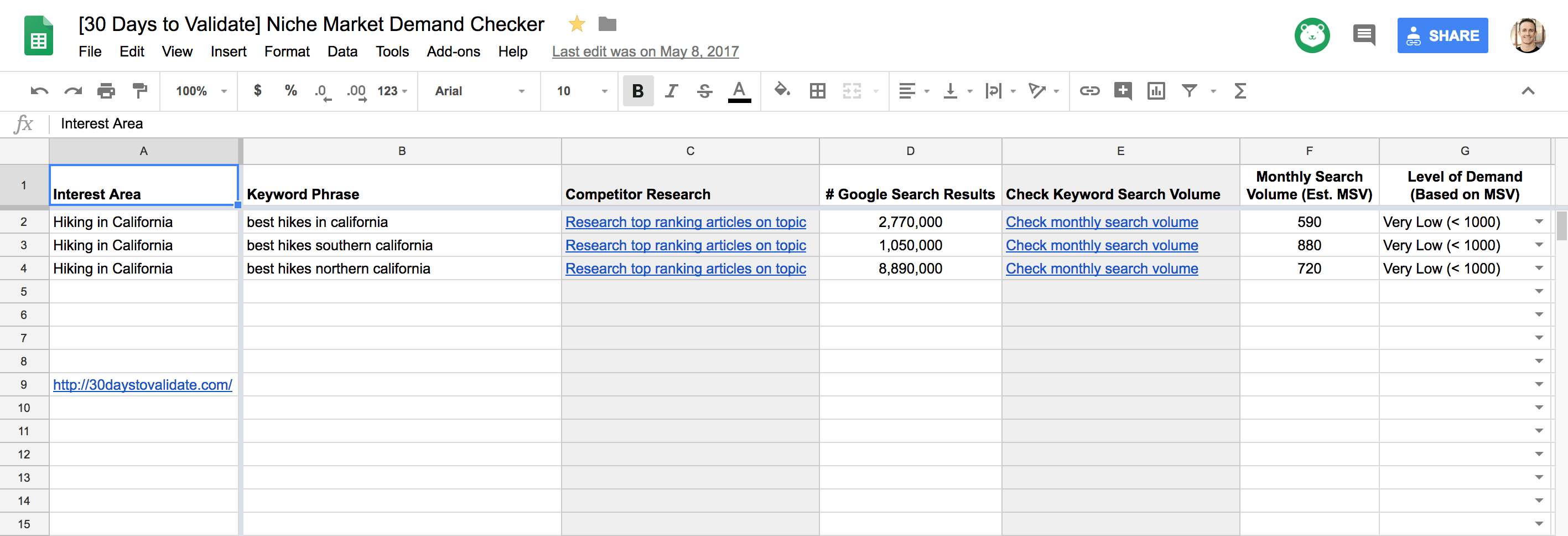
Take the blog niche that you’re thinking about and come up with 5–10 keyword phrases or topics within that niche that you would write about. So, if we wanted to start a blog about playing guitar you might choose keywords like “best guitar books,” “how to play guitar,” “beginner guitar chords,” “what guitar should I buy,” and so on.
Now, let’s do a little keyword research. Enter one of those keywords from above into your Google search. If there are tens of millions (or more) results, that’s a pretty strong indicator that people care about your topic. But to be extra sure, I like to use a free tool like Twinword Ideas to check the Monthly Search Volume (how many people are searching for this term each month).
Do this for each of your keywords and look at the results. If all of your top keywords have a Monthly Search Volume of 5,000 – 10,000, you’ve definitely got a potentially profitable niche. If you’re too much over that, into the high hundreds of thousands of Monthly Searches, you might want to get more specific with your niche rather than competing with much larger, established websites on more popular subjects.
Brainstorming smart blog post ideas (using keyword research)
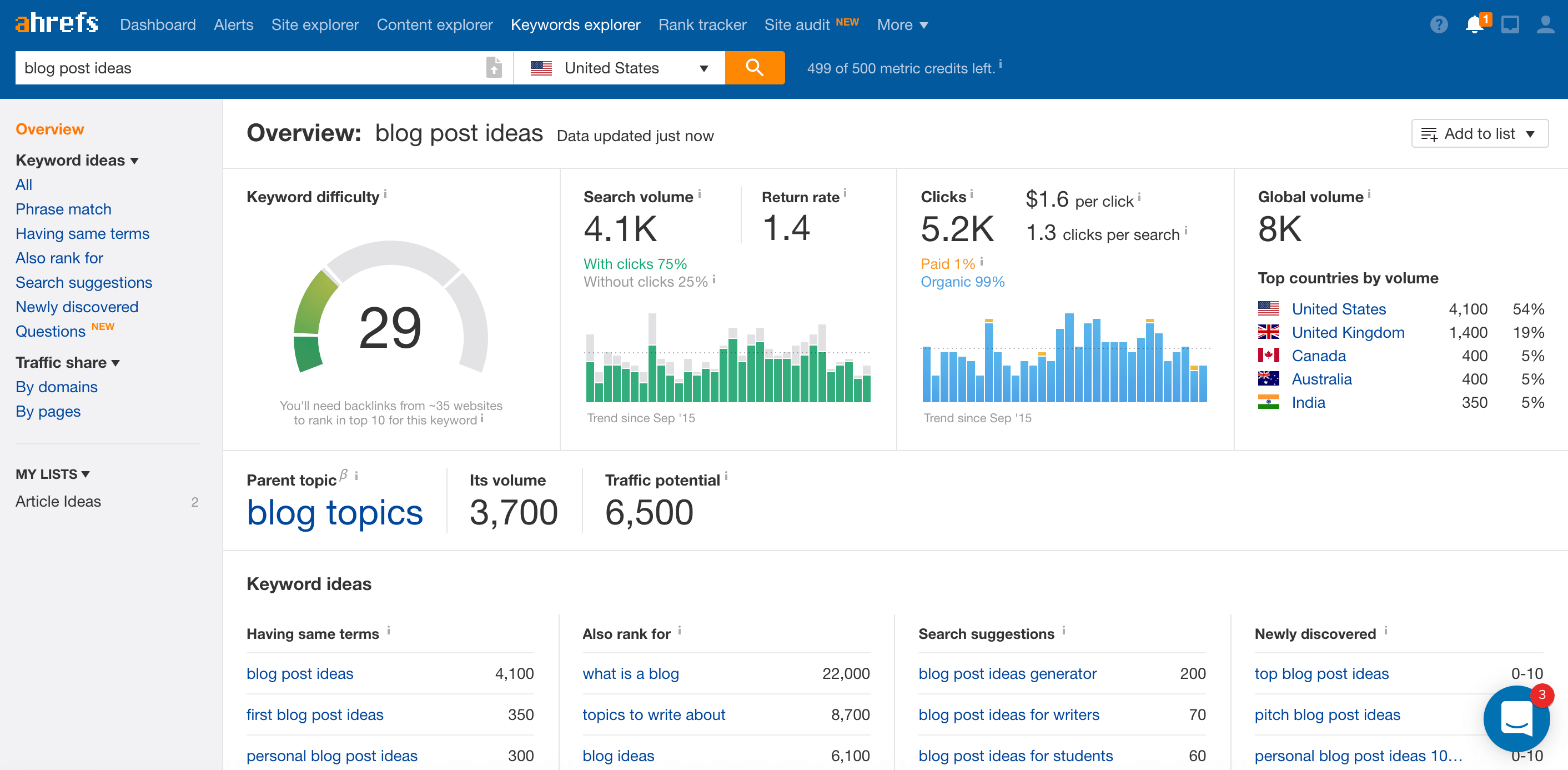
Even once you’ve established the niche you’ll be blogging about, you have to do smart keyword research in order to generate the right blog post ideas that’ll actually bring you readers.
So, what about the actual posts you’re going to write? The good news is you can honestly write whatever you want! This is your blog after all, and one of the major benefits is that it’s your platform to speak and share. But, ideas don’t always come naturally.
This is where I believe a simple editorial calendar is so important. It’s just a basic document to fill out that’ll give you a roadmap to always knowing what you’re writing next. It frees you up to spend more time on the fun of actually putting posts together—not banging your head against the wall trying to come up with blog post ideas.
5 ways to come up with clever blog post ideas
Here’s a simple process I use for coming up with the specific blog posts I write for my own blog.
5 ways to come up with unique blog post ideas (click to expand)
- Brainstorm topics and write them tout down: Start by writing down as many ideas or keywords that you can. Aim for things you know your target audience would find valuable. What questions are they asking? Where do you have expertise and can help fill in the blanks?
- Use a keyword research tool to gather even more ideas: Use a keyword research tool like Ahrefs (pictured above), Twinword Ideas (free), or Moz to get more ideas. These tools will show you terms and topics related to the ones you’ve already come up with, as well as how much traffic those terms are getting (to show that your audience cares about them).
- Lump similar ideas together: Take all of your terms and start to refine them. Are there duplicates that you can lump together?
- Put your ideas in a spreadsheet and prioritize: Now, turn to your editorial calendar spreadsheet and include your keyword, estimated search volume, difficulty and opportunity. Looking at all these, assign a priority to each one topic, on a scale of 1-5 (or a basic High-Medium-Low).
- Outline content that hits all three key needs: Take your top priorities and set deadlines for them. Look for topics that hit all three key needs: Fits your niche, are genuine needs of your readers, and have potential to drive traffic to your blog from search engines. Then write a blog post outline to solidify your main points and get started.
If I’m still left needing more ideas, I’ll turn to a few more creative tactics…
- Seeing what other bloggers in my niche covered (and what did well).
- Taking a look at my most successful posts to see what readers like most.
- Doing more quote roundup posts (like my posts about business advice and online business tools) that don’t require a ton of original thought and effort from my end.
- Chatting with bloggers in my space and brainstorming fresh ideas.
- Talking about specific lessons I’ve recently learned (and my advice).
- Reflecting on the blogging mistakes I’ve made and the tactics that work today.
By this point, I’ve usually got a fully stocked content calendar. Still need some more content inspiration? Here are 201+ winning blog post ideas.
Now you’re ready to write your first blog post
Once you’ve decided on the first blog post you want to write, you’ll navigate to the “Add New Post” section from your WordPress Dashboard.
Go to Posts > Add New which will look like this right here:
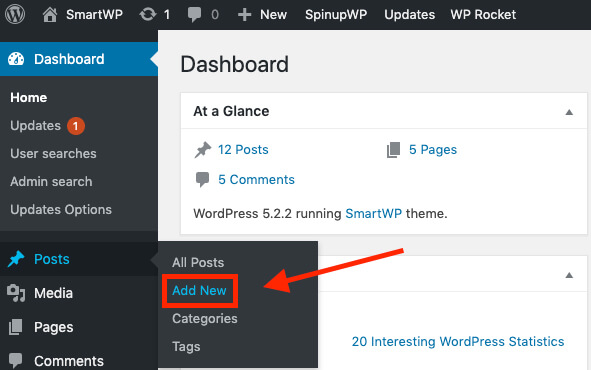
Next, you’ll be taken to a brand new article page that’ll look like this (a totally blank canvas 🙂):
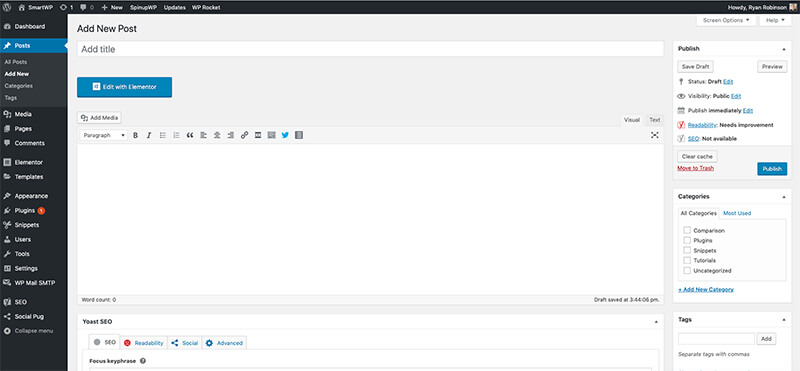
Writing a blog post headline that encourages readers to click through
One of the reasons you’re blogging is to attract readers, right? Well, it pays dividends to put some effort into learning how to write a headline that’ll entice readers and most importantly—deliver on the promise of what your article is actually helping readers to accomplish.
So let’s say you’ve determined that your hiking blog should start by breaking down some underrated hikes in Northern California. Next, click into the “Add title” bar on your new post page and type in a title like…
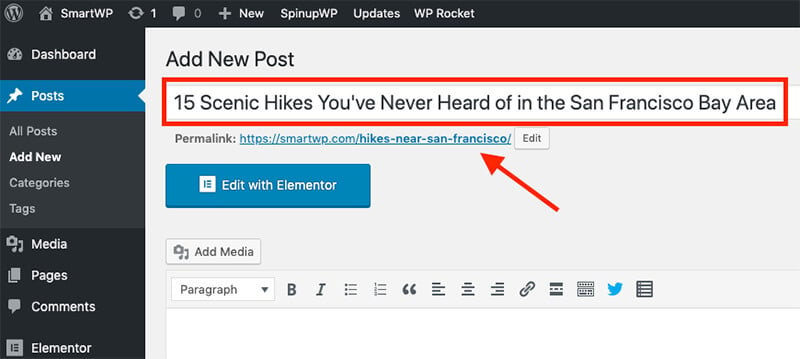
As a starting point to writing a strong title, learn by observing the headlines of other successful bloggers in your niche:
- Do they often lead with numbers?
- How many of their article headlines include parentheses?
- Does it seem like a best practice to capitalize the first letter of every word?
Check out a few of the most recent headlines from my blog so you can get some inspiration on how you might want to structure your headlines (and read my ultimate guide to writing blog headlines).
If you’re still unsure about how to title a new post, then do a Google search for the target keyword phrase you’re going after and gather inspiration for the ways other titles are written—be sure not to directly copy other bloggers, but that’ll point you in the right direction.
Choosing an SEO-friendly blog post URL
It’s extremely important that you customize the URL of your new post, if you hope for it to rank well in organic Google search results.
How to set an SEO-friendly URL for your blog posts (click to expand)
Continuing with our example from above, I’m trying to rank the article “15 Scenic Hikes You’ve Never Heard of in the San Francisco Bay Area” for keyword phrases like “hikes near San Francisco,” so that’s exactly what I’ve chosen as my post URL… /hikes-near-san-francisco
Here are a few more URL writing pointers:
- Remember to separate each word in a new post URL with a dash (for easier readability)
- Keep it short at no more than 3 – 5 words in length (less is better)
- Avoid the use of numbers unless there’s a very compelling reason otherwise
- Always, always, always include your target keyword phrase
Crafting a compelling introduction to your new blog post
You have one or two sentences to convince readers your new post is worth their time. Here’s a sample blog post introduction I just wrote in less than two minutes for our hiking example:
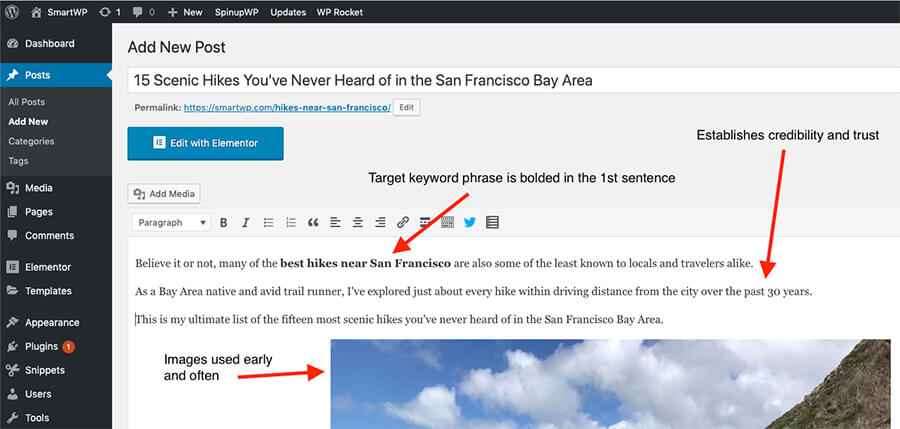
As you’re learning to write a blog post that keeps readers engaged, here are a few do’s and don’ts for crafting a strong introduction.
The do’s and don’ts of writing a blog post introduction (click to expand)
Do:
- Use colorful language
- Open with a startling statistic
- Start with a quote
- Use drama or humor
- Leverage eye-catching formatting (like bold et italics)
Don’t:
- Use a cliche that’ll leave readers rolling their eyes
- Bury the lede (failing to tease the most interesting point in your article)
- State the obvious
The easiest strategy for writing a compelling introduction is to answer the who, what, where, when and why as soon as possible. This may sound counterintuitive, but another trick is to start with your conclusion first. In the age of short attention spans, people have grown tired of wasting time on clickbait blog posts that go nowhere.
The quicker you can establish relevance to your reader, give them a strong reason to believe they’ll find what they’re looking for in your blog post, the more likely they’ll be to dig into your piece and share with others.
Optimizing the design and layout of your blog post
Ultimately, what looks “good” is subjective and up to you, based on what you think your (future) readers will resonate with most. But one of the most important lessons I’ve learned through starting a blog of my own, is that design matters a lot.
5 rules to structuring the perfect blog post layout (click to expand)
1. Make your blog posts readable
Design isn’t about crazy colors, multiple fonts and tons of images. It’s about making the experience of your reader as enjoyable as possible. Negative space is important to the legibility and readability of your blog, so don’t start by cramming design elements everywhere. Look for ways to make things flow easily (a good WordPress theme should do this for you).
Next, make sure your font size is big enough (you’ll want to go 16pt or higher for your blog). You’ll also want to be careful with line length. Most designers say the ideal length of a sentence on your blog is 50–85 characters as it helps keep readers moving through the post. Check out my guides on how to change font size and change font color on your blog for a more in-depth tutorial on tweaking your visual typography settings.
2. Always include a relevant featured image at the top of your blog post
Our human brain has two ways it remembers things—verbally and visually. If you can combine the two at the top of your post with a compelling image, you’ll have a better shot at people remembering your blog.
Pro tip: Don’t worry about custom designed images initially
Take for example, the featured image from this guide(at the top of this post). By including a relevant image at the top of the post (and superimposing the title on it), I’m making a stronger connection with my reader.
3. Use frequent sub headers to break up your text
Looking at a giant wall of text is intimidating and can make people leave your blog. I suggest including a heading or sub-header every 300-500 words. I also try to include images around each heading in my post to break up the flow of text—like I’ve done throughout this guide here.
4. Use styling to emphasize key parts of your post
Great blog design guides your reader through your article. One of the easiest ways to do that is to emphasize key parts with bold or italics like I do frequently within this guide. You can’t say everything in your article is extremely important though, so use it sparingly.
5. Make sure people know where they are
To build a lasting connection and make readers feel comfortable, it’s good to have a short blurb about who you are in the sidebar or footer of your blog to let readers know who you are.
These five time-tested design principles will be immensely helpful in constructing an appealing blog layout (that’s easy for readers to digest).
Hitting publish on your first blog post
Once you’ve written your first blog post (and ideally get it to the 1,000+ word range) you’re almost ready to publish!
Take a few minutes to double check on the Yoast SEO suggestions and ensure your blog post is SEO-friendly, which will give you the best chance of ranking well in organic search.
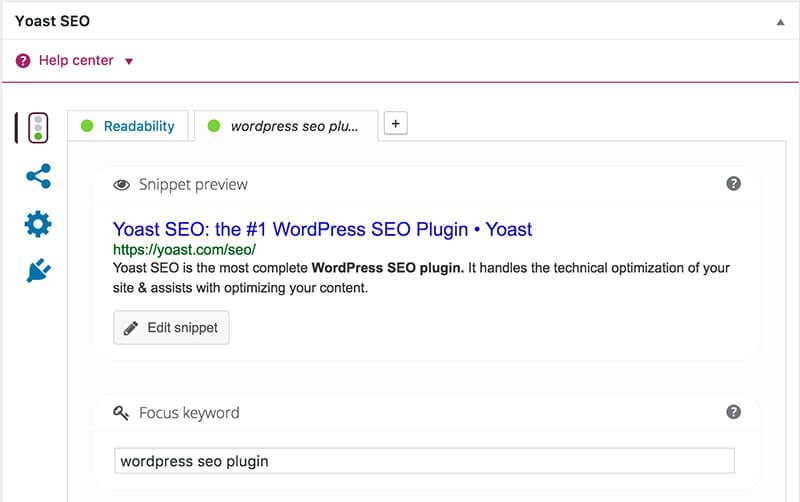
After your SEO settings are dialed in, choose which “Category” this new post will fall under and tick that box. Then, you’re ready to hit publish!
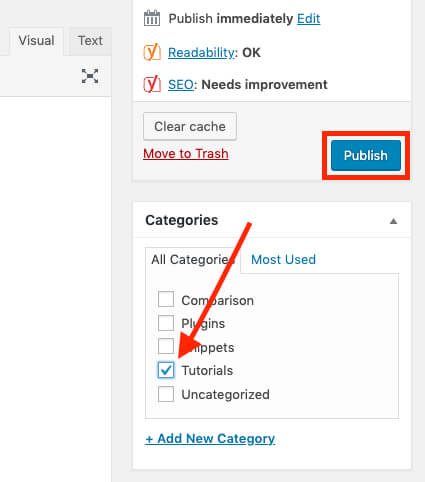
And boom! It’s that easy if you allow it to be 🎉
Now, if like me, you appreciate great design—before you hit publish on your first blog post, there’s one last step you could take.
Studies show that blog posts with images get 94% more views than those without. And when it comes to posts getting shared on social media, tweets with photos get 150% more retweets that those without one, while Facebook posts with images get 2.3X more engagement. Adding a few visual elements can almost double your amount of views and expand the shares a blog post gets.
Free blog photo resources
One of the easiest ways to add some visual flair to your blog posts is with beautiful images and designs. Thankfully in recent years, there are now a number of high quality sites that offer incredible photography that’s completely free to use for your blog—my favorite is Unsplash:
Unsplash (for free blog images and stock photos)
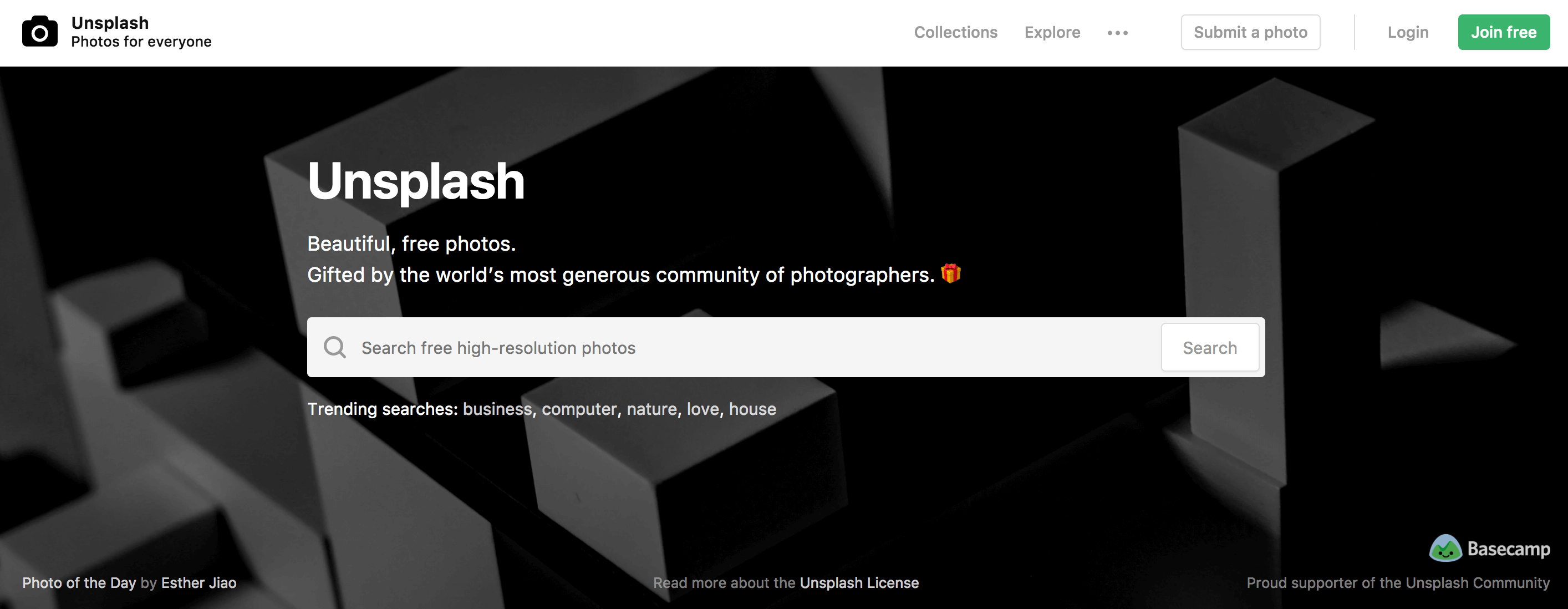
Unsplash is the best online resource for completely free, user-uploaded photos for your blog. Every photo that makes it onto Unsplash is curated by their team to make sure it’s high quality. Under the Unsplash license, you don’t even have to attribute the photographer (however, they recommend you do), which makes Unsplash the easiest option for free blog photography.
Other great free blog photo resources worth mentioning
- Wikimedia Commons: 21+ million photos and images from throughout history that are now in the public domain and free to use.
- Life of Pix: Awesome free-to-use photos donated by an advertising agency in Montreal, Canada.
Bonus: Creating a blog content strategy
I’ve been lucky enough to work for some fantastic companies and get paid to learn about the importance of having a content strategy for your blog. I’ve successfully applied those same lessons to my own blog—making many tweaks and additions along the way.

What is a blog content strategy?
A blog content strategy is simply an actionable plan for systematically growing your blog and bringing in new readers (from the right sources).
- If you know your blog niche and understand your why…
- If you know your blog’s ideal reader and what they’re looking for…
- If you know the value you want to give blog readers and your unique angle…
Then creating a blog content strategy is as easy as solving your readers most pressing challenges.
Here’s how to create a basic blog content strategy today:
- Define your blog goals: What’s your purpose for starting a blog? What do you want to achieve with your blog content? This goal might change as you grow your blog, but it’s still important to know it early on.
- Get to know your blog readers (and where they hang out): Your readers will determine whether or not your blog becomes successful. To write for them, you need to really understand them—which is why it helps if you’re also writing for yourself. It’s useful to some research around the audience you’re writing for. Think about the demographics and psychographics of your target audience. Demographics are the quantitative traits of your readers (age, gender, location, job title) and psychographics are the more unmeasurable traits like values, interests, attitudes and belief systems. Once you’ve written down these qualities, you can start to come up with an audience persona—a fictionalized version of your ideal reader.
- Decide on your blog’s main content pillars: When it comes to deciding what you’re going to write about, it’s good to have a few guiding categories that you’ll refer back to. I like to call these content pillars, as they’re the foundation that holds up the rest of your blog. For example, if you’re starting a blog about personal finance, your pillars might be: personal finance tips, interviews with experts, industry news, paying off debt or otherwise. Each of these pillars can have hundreds of blog posts written under them. They also all work together to show that you’re a thought leader in your niche.
- Map out the content you’re going to create soon after starting your blog: Shortly after launching your blog, it’s worth taking a little time to plan out your content pipeline for the coming weeks (possibly months). You never know when your first blog post might go viral. In that case, you’ll want to have at least a game plan to quickly engage the new readers you get. Even just one or two blog posts under each of your major content pillars is enough to start with.
We’ve now come a long way in this guide. You’ve gone from learning the technicalities, all the way through to publishing your first post.
It’s time to talk about what happens after you’ve published your first blog post… promoting your content, driving traffic and eventually making money from your blog.
Want my Free Course: How to Start a Profitable Blog in 7 Days?
Enter your name and email address and you’ll get instant access to my course that’s been featured on Forbes, Business Insider et Entrepreneur.
5. Promote your blog and get readers
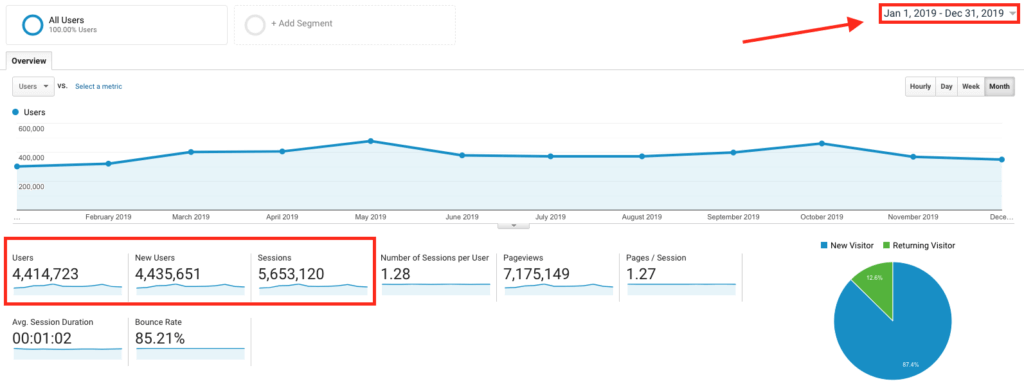
Now that we’re closing out 2020, we can look back and see that my blog brought in 4.4 million+ readers last year alone. We’re going to use my experience in going from starting a blog—to quickly driving millions of readers to my content. What do you do once you’ve hit publish on your first blog posts? It’s time to learn how to promote your blog content.
This is the reason I’m hired as a consultant by companies like LinkedIn, Zendesk, Adobe, Close, Intuit and more—to write content for their blogs, teach them how to promote their content and bring in new readers.
Here are a few of the best ways to start sharing your blog posts and getting them in front of new readers. And if you want even more strategies, here’s my guide to learning how to drive traffic to your website where we dig even deeper into the tactics I’ve used to grow my blog to millions of yearly readers.
Using social media to promote your blog
The obvious first place to turn when you want to find readers is social media. Facebook, Twitter, YouTube, Pinterest, LinkedIn, Reddit, Instagram, Snapchat and TikTok are some of the biggest networks today. Whichever platform best suits your niche and audience interests, is the right one for you. And that’s an important note. There’s no point in trying to promote your blog posts on every social media platform.
Look for the social channels that give you the best return
How to choose which social networks to promote your blog on (click to expand)
Each social network naturally appeals to a certain niche and type of reader. This is a pretty broad statement, but generally speaking, here’s what works best on each social platform:
- Facebook: Videos and curated content
- Instagram: High-res photos, quotes, and Stories
- Twitter: News, blog posts, and GIFs
- YouTube: Video content (2nd largest search engine in the world)
- LinkedIn: Professional content and career news
- Pinterest: Infographics, step-by-step photo guides, visual content
- Reddit: Comments about topics in your niche
Using YouTube to grow your blog audience (click to expand)
YouTube is the 2nd largest search engine in the world (behind its parent company Google), which means it’s also one of the absolute best content discovery networks at your disposal for promoting your blog and growing your audience. From the day you embark on starting a blog, you’ll want to think about a strategy for publishing videos on YouTube with the goal of getting subscribers and driving viewers back to your blog.
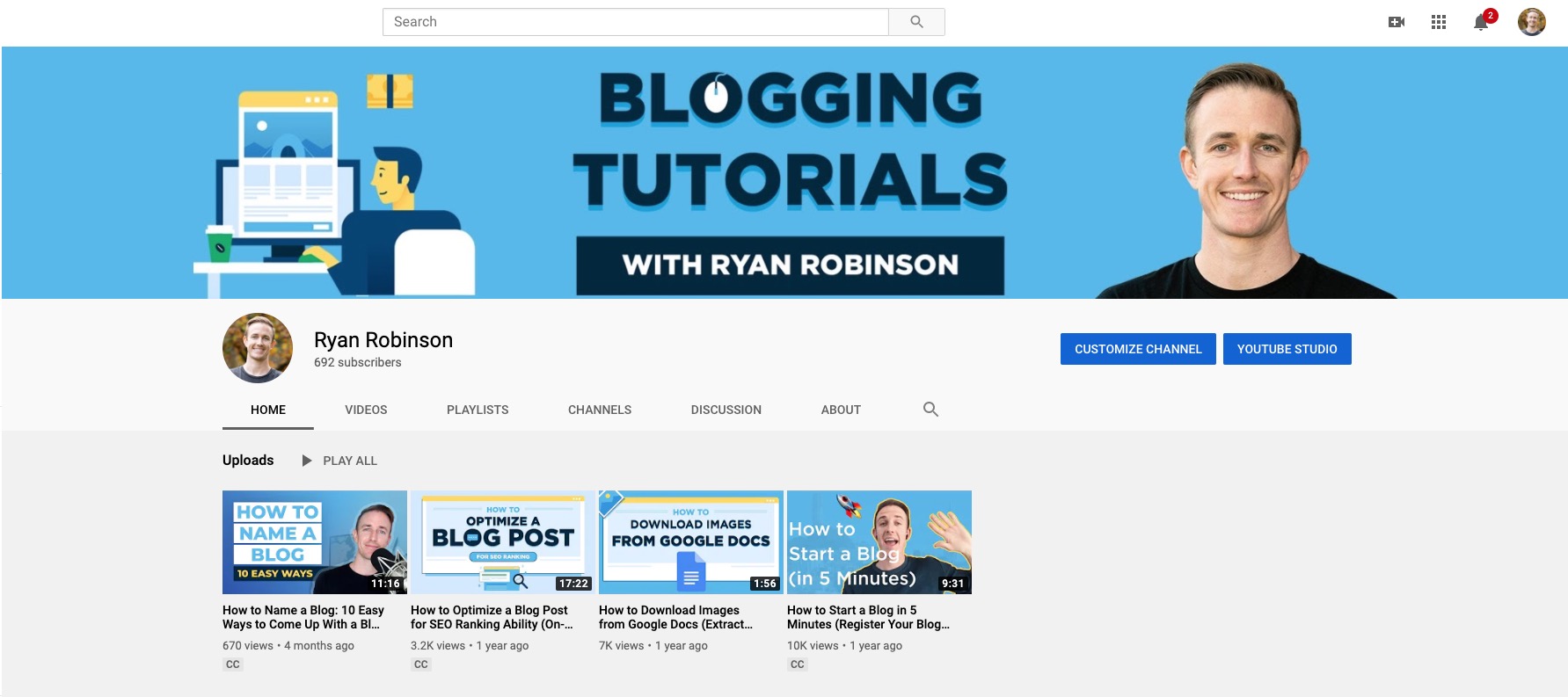
With relatively little efforts (and only a small handful of videos so far), I’ve already used YouTube to get tens of thousands of views on my video tutorials—and reach a new audience of people seeking to learn how to start a blog. Many of those viewers also click through to learn more about the subject I cover in my video content, thus bringing them over to my blog where I can further educate and encourage them to become subscribers (or customers).
3 tools to help manage your social media promotion (click to expand)
Luckily, there are lots of tools that can help you manage your social media posts. With the right tool, you should be able to promote all your posts in just an hour or two a week. Here are my favorites:
- Buffer: One of the easiest ways to schedule social shares in advance for Facebook, Instagram, Twitter, LinkedIn and Pinterest. Their browser plug-in is also great for quickly adding interesting posts you find to your social promotion queue.
- Hootsuite: If you want something a bit more in-depth, Hootsuite is a powerful social sharing, scheduling, and monitoring platform. It’s probably a bit too much for a beginner blogger, but is a worthwhile option to check out once you start to grow.
- Gain App: If you work with multiple people on your blog, Gain is a great tool for collaborating and controlling who posts what from your account. It’s a bit more expensive, but their workflows can save you a ton of time.
The key insight here, is that you’ll need to experiment and see which networks will perform best for you.
Guest blogging on other relevant blogs and sites like Medium, Quora & Linkedin
One of the best things about starting a blog is that you’re joining a community of other bloggers that love to help each other out. Guest blogging on other relevant sites is the #1 best way to connect with an already established audience. Check out my ultimate guide to guest blogging for a full walkthrough, but we’ll cover the highlights here.
I’ve written literally hundreds of guest posts over the past decade, and it’s been the single best strategy for promoting my blog content.
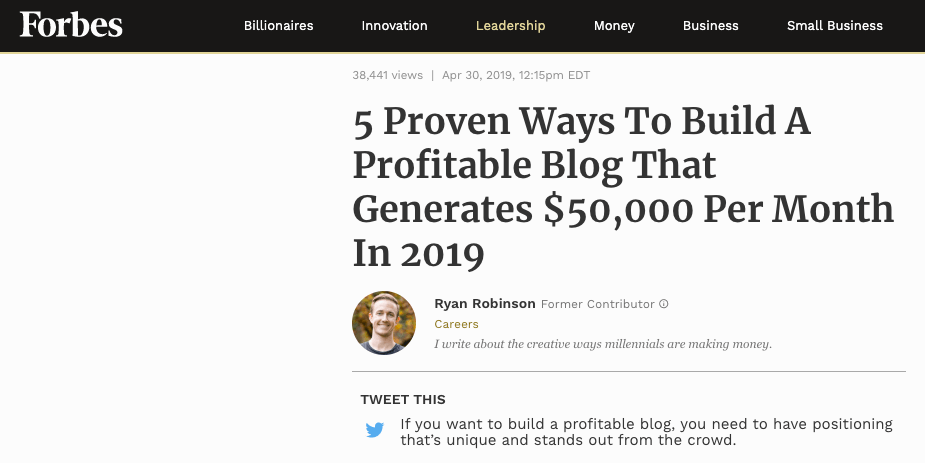
How to land your first guest blog post (click to expand)
One of my biggest breaks came from my first guest post going up on the blog of the social media scheduling app, Buffer. Not only did I tap into their audience of 1 million+ readers, but it also associated me with a brand that people in my niche look up to.
However, getting a guest post on a blog like Buffer’s isn’t easy and I was only able to make that happen because I cultivated a relationship with their blog editor over the course of weeks with intelligent blogger outreach—by first featuring them prominently on my blog (providing value first).
How to republish your content on other blogs (click to expand)
If a large guest blogging campaign isn’t in the cards right now, try reposting your content on Medium. You can even look for a Medium Publication that’s popular in your niche and submit your post to them, in order to reach a larger audience.
There’s also Quora—a question and answer site that lets anyone respond to user’s queries. Search for relevant topics in your niche and then answer questions you’ve already written about on your blog (like this Quora answer I gave about how to get blog traffic, that’s received thousands of views).
Lastly, if you’re more business-oriented in your blog posts, you might want to post them on LinkedIn where that audience spend a lot of their time.
The key point to all of this, is that you want to look for places where your audience is—and be present there, whether that’s other blogs, communities, or social platforms.
Forums and message boards for bloggers
Often, just throwing your ideas out into the social media void isn’t very effective.
Instead, being a part of targeted forums and online communities can give you a way better return on your time—if you find the right ones. Browse through relevant groups on Facebook to see if there are any vibrant communities that’d be a good starting point.
How to find the right forums and message boards (click to expand)
Look for a topically relevant group to join on sites like Facebook and LinkedIn where your audience already exists. You should also do a Google search for terms like “your niche + forum” and “your niche + online groups” to see what kinds of community-run sites already exist.
For example, if you’re starting a blog about photography, you could consider joining Facebook groups like Nikon Digital Camera & Photo Enthusiasts (26,000+ members), Nikon D750 Users (27,000+ members) and Nikon UK Photography (13,000+ members).
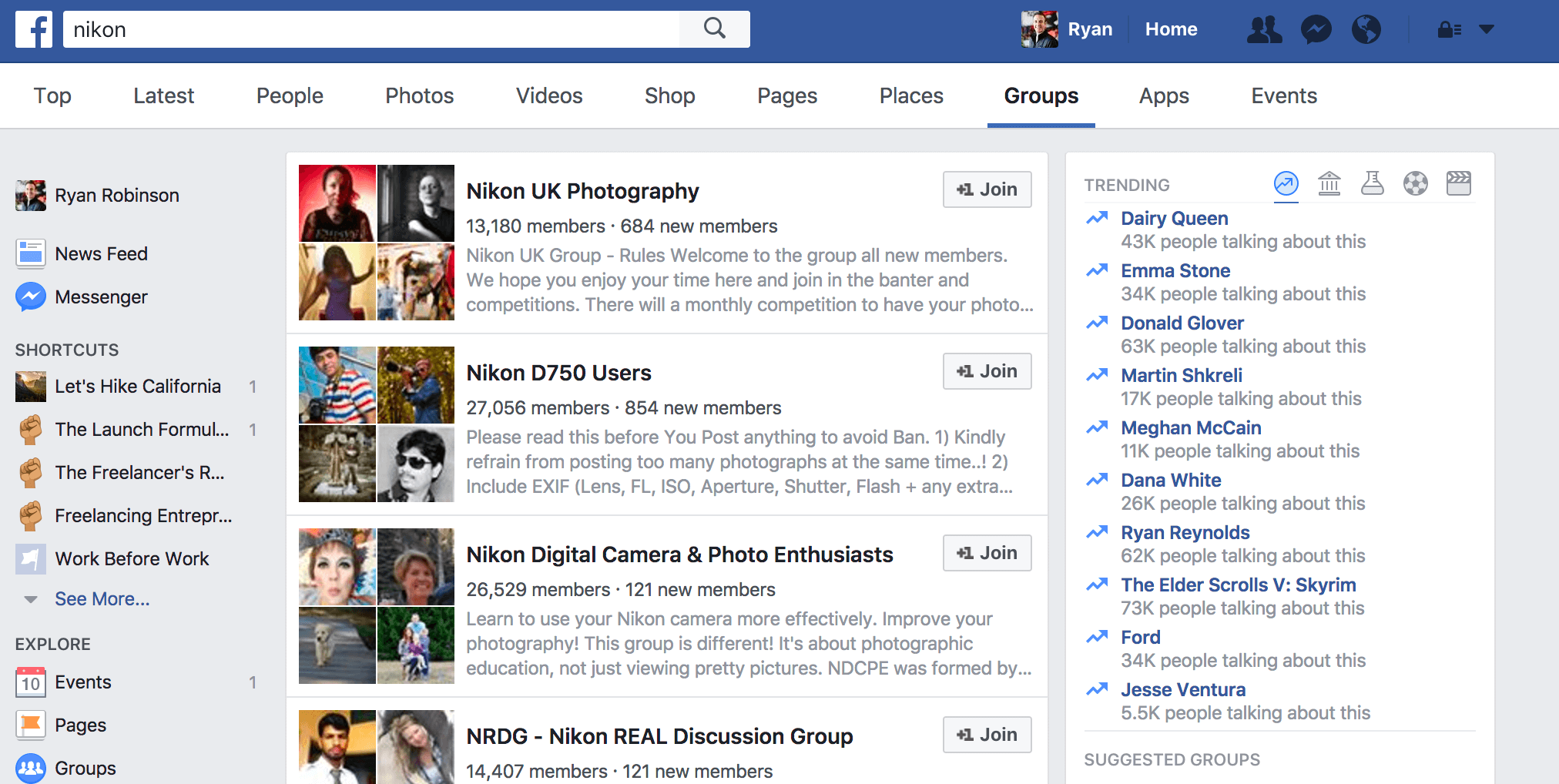
If your blog is relevant to anyone with a DSLR camera, you’re sure to find enough people who’d be interested in reading your posts within those groups.
Now, if your search doesn’t come up with any Facebook Groups with a decent number of members (5,000+), there are other options. Look for more general groups that relate to your niche on Facebook, LinkedIn, Reddit or standalone forum websites.
My favorite online groups for entrepreneurs (click to expand)
If you’re starting a blog oriented around topics of business or entrepreneurship, you might want to try engaging in these groups:
Facebook Groups (Entrepreneurial):
LinkedIn Groups (Entrepreneurial):
Reddit Sub-Channels:
Remember, forums and message boards aren’t just places to dump links to your blog posts. You need to provide value before you ask for anything in return. So, start by building relationships and engaging with people there.
Using an email newsletter to grow your blog audience
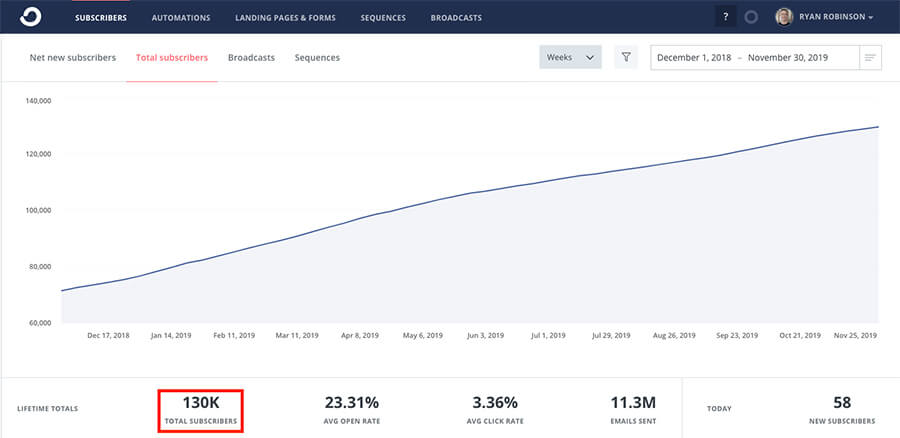
One of the best forms of blog promotion isn’t to other audiences, but to your own (over time). An email newsletter is the most powerful way to keep existing readers engaged with the work you’re doing and one of the things you should set up immediately.
Building your email list can be relatively simple, too. Place a signup form within your posts and across key pages of your site. I use a tool I love, called ConvertKit, to manage the 150,000+ email subscribers I now have on my blog, but Mailchimp is the best free email marketing tool to get started with.
Not sure which email marketing tool to use when starting a blog?
Read through my detailed comparison of ConvertKit vs AWeber vs Mailchimp for my take on where you should start and when to upgrade to more robust email marketing tools.
I send my community an update whenever I post a new blog post, have a resource I want to share, or when new podcast episodes go live—and this now ensures my content will quickly be seen by thousands of people right off the bat. Email marketing has by far been the biggest driver of growth and revenue for my blog, and something I can’t suggest enough amongst all the blog marketing strategies you can invest in.
Other ways to promote your blog and get more traffic
Outside of promotion on social media, through guest posts, in forums and over email—here are a few other techniques I’ve personally used to grow my blog audience quickly.
4 more creative ways to promote your blog (click to expand)
- Interview people in your niche: There’s nothing better than learning from famous people in your niche. Not only does interviewing them help you build a relationship, but other people reading your blog want to hear from them. You can use these interviews for blog posts or even start a podcast like I did with The Side Hustle Project.
- Network with other bloggers (and mention their blogs): Early on, you want to get on the radar of other bloggers in your niche. And one of the best ways to do that, is to mention their content from within your own. That often means linking out to relevant blog posts and then emailing the blogger to say, “Hey! I mentioned you in my most recent article. If you think it’s worthy of a share, I’d really appreciate it. But if not, I’m happy to keep sharing yours.” This can drive real results, quickly.
- Talk to people about what you’re doing: It might seem simple, but telling the people around you what you’re doing can build real momentum. Maybe it’s just your friends reading during the beginning as you just start your blog, but you should respond to every comment and go comment on other blogs too.
- Learn from other top bloggers: If you don’t feel ready to connect with other bloggers in your space, at least try to learn from what they’re doing—like what can be found in my epic compilation of the best blogging advice. Study people who are good at what you’re doing, look at what works for them and see how you can use it in your own way.
Remember that the only thing standing in the way of growing your blog is you. It’ll take some ingenuity and the willingness to experiment, but it’s well worth the effort.
Almost every guide about how to start a blog stops long before this point. Now, I’m going to equip you with the tools (and strategies) to go from starting your new blog—to building a true business around it—based on my experience growing this blog to more than 500,000 monthly readers and $50,000/mo in revenue.
Let’s talk about how to (eventually) make money from your blog.
6. Make money from your blog
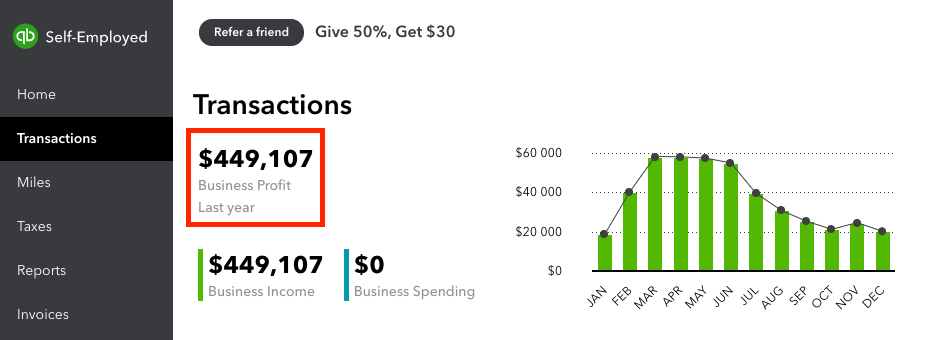
Last year alone, my blog generated $449,107 in revenue (ignore the $0 in expenses here, you can see those details in my blog income reports).
I share this not to brag, but so that you’ll understand I know what I’m talking about when it comes to starting a blog and making serious income with it. Moreover, I’ll be the first to tell you that these kinds of income figures aren’t typical with blogging—and that it’s taken me 6+ years to reach this point in my blog business.
There’s a reason why making money from your blog is at the end of this guide to starting a blog. Unless you have a huge audience somewhere already, you can’t expect to make money right away—monetization should not be your #1 focus at the moment, but rather something to work towards.
Even still, it’s good to have an idea of which ways you’d like to make money blogging as you go into this new adventure. Some of these monetization strategies will be easier than others to implement while your readership is still growing.
1. Freelancing (Selling Your Services)
If you want to begin earning from your blog as quickly as possible, then selling your services (by landing blogging jobs, freelance writing gigs or otherwise selling your expertise as a service) is the easiest option by far. In fact, up until very recently, I was still freelancing as a blog monetization channel for my own business:

All you really need in order to land a freelance client, is a strong enough pitch, which is where choosing to start a blog (first) will help significantly. You’ll want to build out your key pages (About, Contact, Hire Me) and showcase at least a couple examples of the type of work you’ve done that you’ll soon be pitching freelance clients on.
If you don’t have those work samples yet… don’t let that hold you back. Create those sample articles, designs or other deliverables and host them on your own blog as if they were a project you got paid to produce.
If you have a skill that you can sell as a service, then you’re already prepared to go out and start pitching potential clients. That skill could be something like…
- Writing (one of the top blogging skills you’ll want to command)
- Design
- Photography
- Commercialisation
- Developing (check out these WordPress developer job sites)
- Public relations
- Social media management
- Virtual assistance
- Community-building
- SEO or paid advertising campaigns
- Business strategy or project management
- The list goes on… because any skill can be monetized
Today, I still regularly book new freelance clients (like LinkedIn, Zendesk, Adobe) for $5,000/mo or more and I’m brought on to advise and execute on creating blog marketing campaigns for their organization.
If freelancing sounds like your cup of tea, you’ll want to grab my (free) collection of all my best resources, tools and templates for freelancers. That resource bundle is the culmination of more than 8 years of refining my freelance contract template, proposal template, cold email templates that convert new clients and more.
I also put together an in-depth guide to getting started with freelancing that you’ll want to read and another great foundational read about how to develop a pitching process that works for your type of business, is my freelancer’s guide to cold emailing. And if you want to try out some of the websites where freelance clients are already looking for talented help, here are my lists of both the best blogging job sites and the best freelance job sites.
2. Affiliate Programs
Every month, I earn a substantial amount of passive income from the affiliate programs that I’m a member of (sometimes in excess of $50,000+). For example, here’s a screenshot of my blog income from just one affiliate program (Bluehost) for the first 5 months of last year.
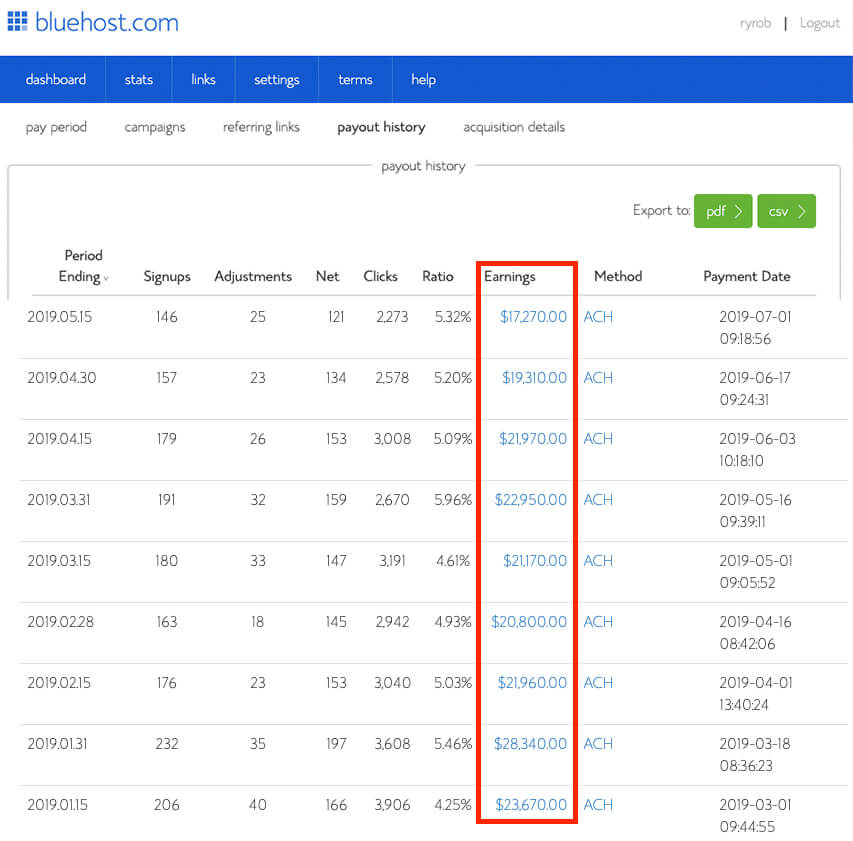
Since starting a blog here a little over 7 years ago, affiliate income has gradually grown to become the largest revenue source for my business—and I’ve structured my blog to generate affiliate income because of how passive it is once you’ve done the (hard) work to find a sustainable traffic source for your content.
How do affiliate programs work?
Here’s how affiliate programs work: You get a special tracking link from the company you’re an affiliate for. Then, you’ll place that link within posts on your blog, emails to your blog subscribers and weave it in elsewhere that you reach your readers. When someone clicks on that tracking link and completes a purchase, sign up (or occasionally another metric), then you earn either a set fee or percentage of that sale. You’re getting compensated for referring new customers to your affiliate partners. My roundup of Bluehost reviews is a good example.
Most of the biggest brands have affiliate programs. Think companies like Amazon, all the way down to key players in specific niches like online education where brands like CreativeLive and Udemy have lucrative programs. Here’s a snapshot of my recent earnings from just a couple of other programs:

Once you build a small readership, you can go out and broker a more advantageous affiliate deal with companies that have relevant products you want to promote to your audience. For a LOT more on the subject of monetizing your blog with affiliate income, check out these guides:
3. Sponsored Blog Content
Unless you already have a decent sized audience on your blog (or social accounts), it’ll take some time to grow your readership to a point where sponsored content is a viable monetization option.
What is sponsored blog content?
Generally, it’s when a brand, company or individual pays you a fee in order to get their content (or offer) in front of your audience in the form of a blog sponsorship.
How much traffic do you need in order to get blog sponsors?
It depends a lot upon the niche you’re blogging in and how engaged your readers are, but expect sponsors to want your traffic to be at around 5,000+ monthly readers (or more). That can take some time to achieve. For example, here’s a snapshot of my first year of traffic (in orange) when I started blogging—and my second year of traffic (in blue):
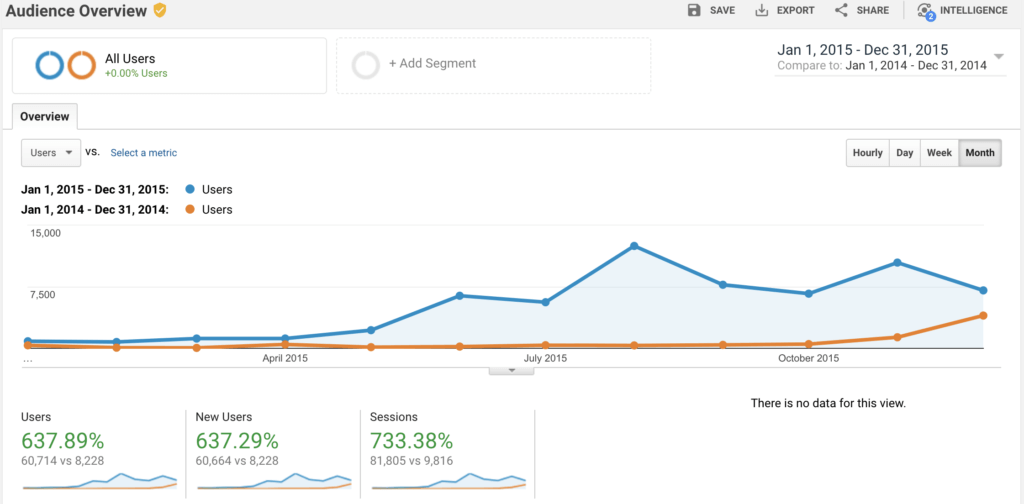
As you’ll see, my first year of blogging saw only about 9,000 total readers, but in my second year, you’ll see traffic begins to pick up dramatically as I start to figure out who my audience is and which traffic strategies work best for me. It was at this point, once my readership grew to around 10,000 monthly readers (on average), that it became a viable option to start doing sponsored content.
The best way to do sponsored content without alienating your readers, is to weave it into your typical publishing style (like I’ve done with this sponsored post and this one too).
4. Online Courses
Once you have a skill (or experience) that others also want to learn, it’s relatively easy to package your best advice (like my blogging tips), strategies, tactics and tutorials into an online course where people can pay for access to accelerate their learning much quicker than they otherwise would going through the stumbling process of learning through trial and error.
Last year alone, I generated over $60,000 from the launch of my premium blogging course, Built to Blog, which takes students far beyond just starting a blog and into advanced strategies for getting readers & generating revenue from their blogs.
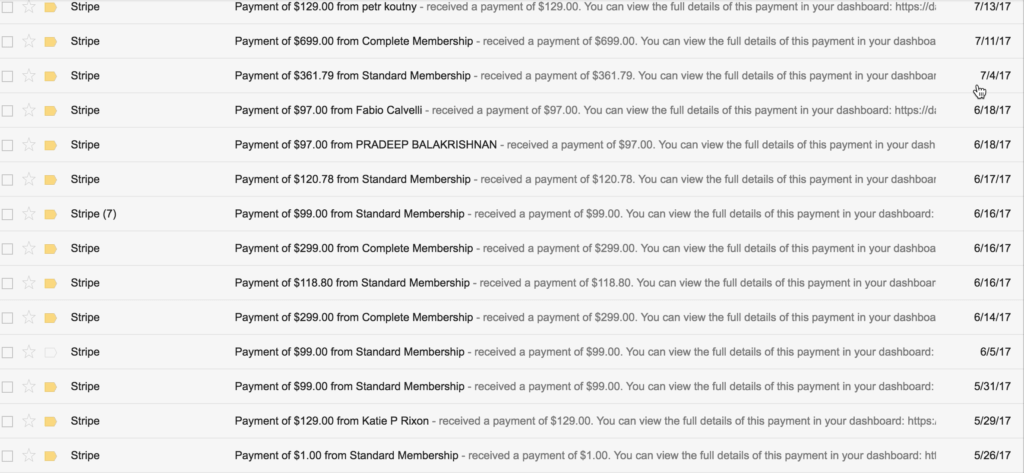
What’s great about an online course as a monetization path for your blog (or like I’ve done with selling blogging books too), is that you don’t need a huge audience in order to earn from online courses. The same goes if you choose to write an ebook and sell that digital product to your audience.
How to launch a profitable online course (click to expand)
Once you have some readers coming to your blog, encourage them to interact with you—ask questions, offer free downloads, share advice and get them to either join your email list or to personally reach out and connect with you.
Learn about their biggest challenges (as related to the broader topics covered on your blog). Pinpoint the ways you can uniquely help them by leaning on your own skills, knowledge, experience. After you’ve determined the right way to help a handful of your readers solve a real problem they’re encountering, pitch them (individually in a very personalized manner either over email or ideally on the phone) on pre-ordering your course and getting direct coaching from you in the meantime while you work on building out the actual course material.
Asking people to actually give you their hard-earned money will validate whether you’re really solving a true problem for them. You’ll also get live test subjects to help build and curate your course content in real-time with. Follow along with my idea validation framework where your focus remains on pre-selling a course to a small community of early adopters.
5. Traditional Blog Advertisements (Ad Networks)
I used to have several small blog advertisements displayed across my content (from one of these top blog advertising networks) that would earn me around $1,500 to $2,000 per month in incremental revenue, before I turned advertisements off in favor of optimizing for other sources of income.
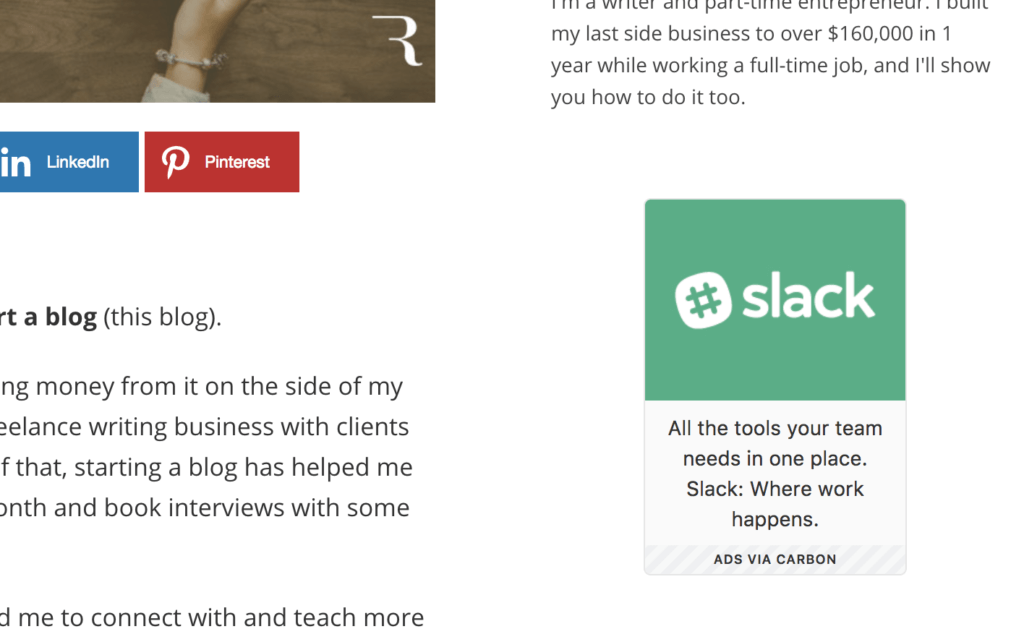
I was a member of a small ad network called Carbon Ads for the first few years of my blogging journey, where they partner with bloggers and pair us up with ads from high-quality startups like Slack, Asana, Freshbooks, Monday, Upwork and other targeted brands that my audience is already familiar with.
How much can I earn from blog advertisements?
With around 300,000 to 500,000 monthly readers on my blog, I only earned about $1,500/mo from being a member of the Carbon Ads network. Plenty of other ad networks offer higher CPC (cost per click) and CPM (cost per 1,000 impressions) rates, but aren’t as restrictive in the types of products that are allowed to advertise on your site.
What are the best ad networks for bloggers to join?
Some of the best blog ad networks to consider applying to include Mediavine, Monumetric, Google AdSense and Propeller Ads. Depending upon the niche you’re blogging about, there may also be a handful of dedicated ad networks offering higher payouts than the competition in your space.
All in all, traditional CPC or CPM advertising doesn’t become very profitable (at least as a viable source of substantial blog income) until you’re driving more like 1 million+ monthly readers, so it’s not a great monetization channel to focus on in the short-term. But, when you’re starting a blog, it can be one of the easiest ways to make money from your traffic without much extra effort.
6. Podcast Sponsorships
Another great way to start monetizing your blog is by launching a (simple) podcast for your readers. You can use your traffic and early listener numbers to book sponsorships from brands that want to reach your type of readers & listeners. Here’s the growth trajectory of my podcast over it’s first year:
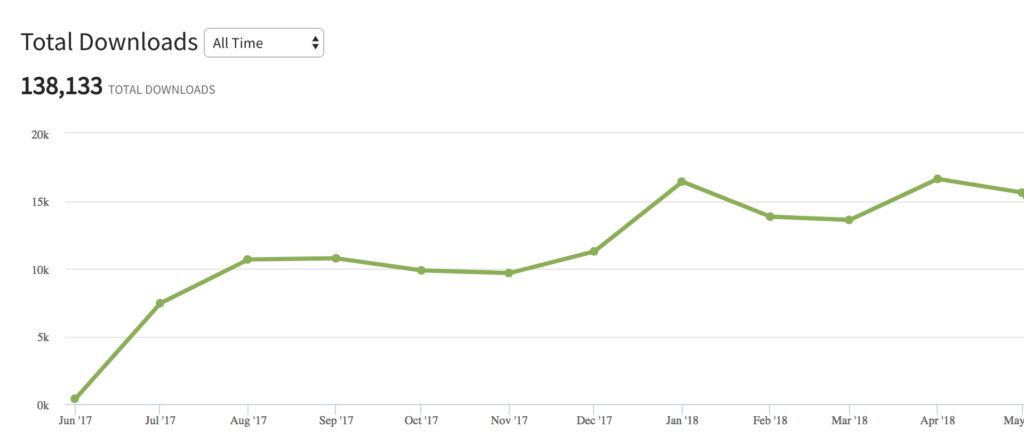
You can even combine podcast ad placement offers with sponsored blog posts on your site to really sweeten the deal. And I understand that launching a podcast while you’re still mastering blogging sounds like a diversion, but keep in mind that a podcast can be as simple as casual conversations with other bloggers in your industry.
How to make money with podcast sponsorships
When I launched my show, I already had about 100,000 monthly readers on my blog and 20,000 email subscribers to seed the early listenership numbers. That helped me sell an early sponsorship slot for 10 episodes to Freshbooks at $500/episode to help fund my new podcast.
That worked for me because of where my blog was already at—but when you’re starting out with less traction, I recommend getting a few episodes recorded and launching your show without trying to book a sponsorship in advance. Those that tune in and like your show will subscribe and stick around. One of the best ways to reach more listeners is to be a guest on other (more established) podcasts in your space, so try pitching yourself as a guest to go on other shows.
For many more on the mechanics behind launching a podcast and monetizing it alongside your blog (including choosing the right podcast hosting), check out this episode of my show with Michael Sacca of Rocketship.fm, whose grown his podcast into a $10,000/mo source of side income while he still holds onto his day job in sales and marketing. It’s a true masterclass in starting a podcast that you don’t want to miss.
7. Physical Products (eCommerce) and Software Tools
Similar in concept to launching an online course to your blog audience, another great way to monetize your audience is by selling a physical product or software tool to the people in your community—especially if you’ll be starting an eCommerce store (with the right eCommerce website builders) to sell products that are related to what your readers need.
At the end of the day, this one all comes back down to solving the problems your blog readers have.
What once used to be a much more labor intensive business, eCommerce has become a great way to monetize an audience of readers on your blog—especially with the proliferation of drop shipping and order fulfillment services.
On top of just selling to your own audience, you can leverage loyalty programs that incentivize customers to invite friends to purchase with offers like first-time customer discounts, free one-month trials, gifting programs and more. These channels create opportunities for amplifying your message and spreading your products through word-of-mouth marketing efforts that won’t cost you anywhere near that of similar advertising fees.
How to (simply) launch a product to your blog audience
If you can create a blog and quickly build a relationship with just 10 early readers, then work with them to pinpoint a challenge you’re interested in building a physical or digital product for. Focus next on repeatedly solving that problem yourself, then develop a plan of action for how you can personally help those 10 people solve that problem in their own unique situations as well.
Next, ask these 10 readers to “pre-order” the product from you and work with them through a personal coaching regimen that you’ll use to make sure your eventual product has all the necessary features in order to successfully solve their challenge. At the end of this validation process, you’ll emerge with a solution that’s built on the foundation of genuinely helping your readers.
Tune in to my interview with Hiten Shah, who went from teaching himself how to start a blog, to now using his personal blog as a way to connect with his audience and release profitable software tools as a result of the validation conversations he’s had with them.
8. Business Partnerships
Of all the ways to monetize your blog, this is the most amorphous. Who knows who you’ll meet as a result. What about future guests on your podcast? The possibilities here for stumbling into partnership opportunities are endless.
As a result of sticking with my blog for several years, I’ve been able to use it as a tool to meet some incredibly talented entrepreneurs. Here are a few examples of how my decision has turned into profitable partnerships:
- I’ve collaborated with my friend Jory (a writer) that I met because of my blog, on growing a $10,000/mo content marketing agency together
- I’ve launched new websites (like SmartWP) with my friend Andy who has a similar audience as my own
- I’ve worked with a former podcast guest to help build a software tool I’ve envisioned for years
It’s true that there aren’t as many ways to authentically engineer the creation of these types of partnerships—aside from growing your brand and the reach of your blog—then being receptive to the creative people & ideas that come your way as they discover you.
On the flip side, if there’s someone in your space that you really want to collaborate and work with, strategize on a way you can add value to their business.
How to Start a Blog in 2021: Final Takeaways for New Bloggers
Ultimately, growing a successful blog all boils down to being excited and engaged with your new blog. If you want people to read what you’re writing, you need to give them a reason to.
Write exciting content, connect with people in your niche and enthusiastically share what you’re working on.
The traffic, monetization and everything else will follow.
I wrote this guide because starting a blog has been one of the most empowering, life-changing decisions I’ve made in my life.
And I hope that by now you feel confident enough to go out there and start a blog of your own.
I’d love to have you in my free 7-day course that expands on the teachings of this guide. We also dive even further into topics like driving traffic, my personal writing process, monetizing your blog and more.
Want my Free Course: How to Start a Profitable Blog in 7 Days?
Enter your name and email address and you’ll get instant access to my course that’s been featured on Forbes, Business Insider et Entrepreneur.
Infographic: How to Start a Blog (for Profit) This Year
For those more visual learners, I also put together this infographic breaking down the process of starting a blog—and my personal experience generating both traffic et revenue from your blog. Prendre plaisir!

Want to share this infographic about how to start a blog on your site? Email me at ryan@ryrob.com and I’ll hook you up!
How to Start a Blog FAQs (Frequently Asked Questions) People Also Ask
I get dozens of questions every day from readers (like you), who are learning how to start a blog for the first time. Here are my answers to the most common beginner blogging questions people also ask when starting to blog.
Getting Started FAQs
What is a blog?
A blog is a regularly updated website where new content is frequently published, typically written in an informal or conversational style—often with the goal of attracting readers and achieving some sort of goal, whether community-building or growing a business. For more, check out my full guide: What is a Blog? How a Blog is Different Than a Website.
Can you start a blog for free in 2021?
If you’re just starting a blog for the first time, you might be worried about the cost of building and hosting your own blog. Luckily, today that isn’t much of an issue. There are tons of ways you can start blogging for free.
Free blogging platforms like Medium, Tumblr and Blogger are awesome resources for testing things out. And these options are great… si your blog is a hobby. The same goes for choosing a free hosting plan from providers like WordPress.com.
However, if you’re looking to build a business out of your blog or make money blogging, I would highly recommend some of the paid (yet still très affordable) options like Bluehost that we covered in this step-by-step tutorial. If you’re on the fence about whether to use a free or paid hosting provider to get started… here’s why you should consider (an affordable) paid hosting provider:
- When you go with free, you’ll have a lack of control over how your blog looks and acts
- Most free services have limits on monetization
- Switching or upgrading to a better service eventually is a hassle
- There’s a lack of support if something goes wrong
- Free blog hosting services can disappear overnight
All of this is to say that you should think about your plan and what you want from your blog before you get started. While it’s perfectly fine (and easy) to learn how to blog for free and build up your skills a bit, sometimes a little investment in yourself up front can go a long way toward paving a future that’s much more lucrative.
How do you start a blog for free?
If you want to start for free, you’re in luck! There are tons of ways you can get started today (in half an hour or less) that are absolutely free. Free blogging platforms like Medium, Tumblr and Blogger are great places to begin practicing at building your writing skills—especially if your blog is meant to be a hobby. Just head over to one of those sites, set up a free account, and you’ll be blogging in a matter of just a few minutes.
Over the long-term however, if your goal is to generate an income from blogging, or eventually build a business around your blog, choosing to go with one of the many affordable hosting platforms like my personal favorite, Bluehost, or strong alternatives like Dreamhost and HostGator will afford you many more options for customization, your own dedicated domain name (like yourblog.com), and the guarantee of hands on help & support with any technical challenges you face over the months and years to come with your blog.
How much does it cost to start a blog in 2021?
Depending upon your goals and the type of blog you want to start, it costs around $34.50 to $65.40 (minimum) in 2021 and cover your first year of expenses if you’re only spending money on an affordable shared hosting plan (or opting for an eco-friendly green hosting plan)—and doing all of your own content writing, utilizing organic promotion efforts and otherwise keeping to a tight budget.
If you need to factor in buying a computer, phone or other hardware into your equation for how much it’ll cost to start blogging—then that can add anywhere from $200 to $2,600 in one-time purchases depending upon the brand of computer (Windows vs Apple) and features (MacBook vs MacBook Pro) you decide upon. Plus, there are a lot more variables to consider when it comes to how much it costs, depending upon the kind of blogger you want to be:
- Hobby Bloggers (blogging solely for fun or as a creative outlet)
- Side Hustle Bloggers (blogging on the side of your day job to slowly build a business)
- Full-Time Bloggers (blogging as a full-time business, where you’ll likely want managed WordPress hosting too)
If you’re just getting started and want to keep your new blog on a tight budget, you’ll have a different threshold for costs compared to someone who’s running a blog that already generates a little income when it makes sense to upgrade into more premium expenses like the best web hosting, better plugins, themes or more robust email marketing tools.
- How Much it Costs to Start a Hobby Blog: $34.50
- How Much it Costs to Start a Side Hustle Blog: $65.40
- How Much it Costs to Start a Full-Time Blog: $941.40
Here’s a graphic that also illustrates how much it costs to start blogging this year.
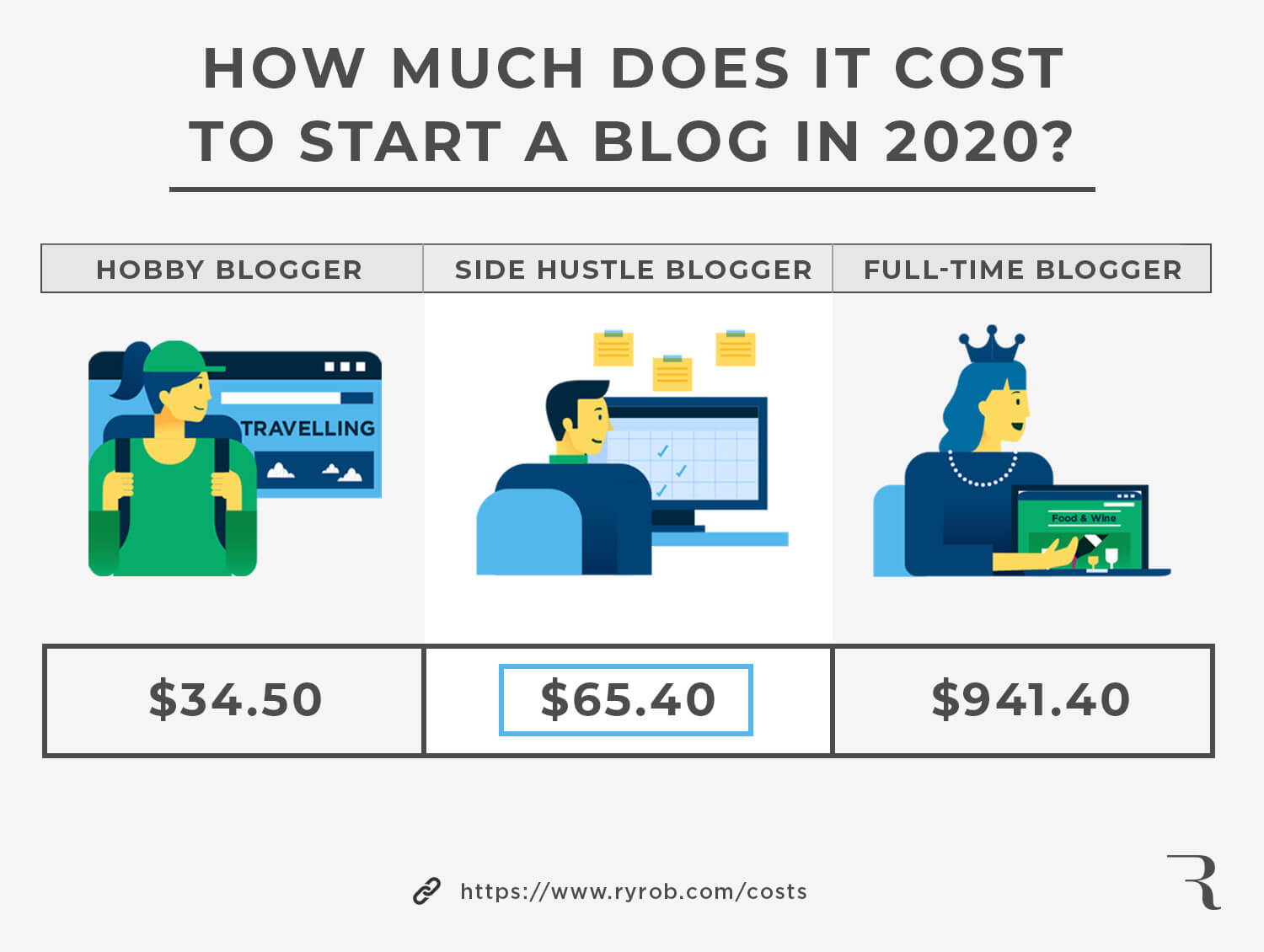
And if you want an even more in-depth analysis, read through my guide to creating a budget for your blog and deciding which costs you should spring for as you grow your blog.
Is blogging still relevant in 2021?
Yes, absolutely—people still read blogs. Thus, blogging is more relevant in 2021, than ever before. Today, my blog earns me anywhere from $20,000 to $60,000/mo in income. That’s pretty damn relevant if you ask me, and millions of other bloggers are building businesses on the backs of starting their blogs and learning how to monetize their audience.
Whether you’re starting to blog on the side of your full-time job—with hopes to grow it into a profitable business one day—or you’ve got some other goal in mind, blogging is one of the absolute best ways to build an audience.
And if you can create an audience of people who are tuning into your regular content, then you’ve got the foundation for building a real business by serving those people with either your own products and services or by recommending other products and services (while collecting an affiliate fee for that referral).
Why should I start a blog? 6 good reasons to (and 4 reasons not to)
If you’re considering starting a blog, here are six good reasons why you should get started today:
- Good Reason #1: You’d love to write about a particular topic (and eventually get paid)
- Good Reason #2: You want to build an online business for yourself
- Good Reason #3: You’re looking to build your personal brand
- Good Reason #4: You want to make a difference in the lives of others (a blog can be your platform)
- Good Reason #5: You’d like a new (profitable) hobby to explore
- Good Reason #6: You enjoy learning new things
If one or more of these motivations above ring true to your feelings about blogging—then you should without a doubt give it a try to see if it’s right for you.
On the other hand, there are also some reasons not to start a blog. If your goals, ambitions and motivations are misplaced from the start, then it’ll be extremely difficult for you to get enough traction with it to continue growing your audience over the coming months and years.
If you primarily identify as having one of these below motivations , I’d reconsider whether or not a blog will actually be your best vehicle for achieving these goals:
- Bad Reason #1: You want to make money very fast
- Bad Reason #2: You want to write (only) about your life
- Bad Reason #3: You read a lot of blogs and it looks pretty fun
- Bad Reason #4: You want to get free products and comped trips
There are other ways to achieve the goal of making money online. You can use a free platform like Instagram or Medium to write about your life for friends and family. Don’t rush into blogging thinking there won’t be some serious challenges along the way (it’ll take at least 3 to 6 months for you to start earning from your blog). Building an Instagram following will be a faster (and easier) path to just getting free products and sponsored trips, than blogging.
How do you pick the right name for your blog?
Since deciding how to name your blog is one of the most common questions I field from new bloggers, I wanted to expand on this topic a little bit more here.
First, dig deep into your niche and uncover why you decided to start a blog. After learning how to pick your niche, the first thing you want to do is get familiar with other people in your industry (if you’re not already).
For example, if you want to start a blog about hiking and you live in the state of California… one name you might consider for your blog could be letshikecalifornia.com. Check out the other blogs in your niche and pay special attention to how they name and brand themselves.
Is there anything you can learn from, play off of, or subvert? Don’t just think about the biggest bloggers in your niche, but look for fresh inspiration and things that stand out to you. You can even get a little outside your niche and look for words that some of your favorite companies use. I like to call this looking for “good words.” Which words keep popping up that you’re drawn to? Make a list of these.
Next, identify the message you want to deliver
You’re going through the work of starting a blog for a reason, and a powerful name for your blog may be sitting at the core of your desire. Go back to your list from picking a blog niche and dig into what represents the core message you’re trying to communicate. As Nate Weiner, founder of Pocket said:
“The first question to ask yourself is why do you want to rebrand? What does your company and product mean? Where do you want to take it into the future? Does your existing or new name let you do that?”
This might feel like a big question, but don’t let it paralyze you. A great name has meaning, but there are plenty of good ones that are just plain fun and memorable.
Now, put yourself in your reader’s shoes
You’ve laid some good groundwork, but now it’s time to get serious. Think about your future blog’s general topic area and who your ideal reader is. What do they want to read? What’s going to grab their attention? What’s going to tell them they avoir to read your blog?
Start with a list of everything you want your blog to be about. Go deep. There are no bad ideas here.
Once you’ve got a massive list, start to look for connections and combinations that might work. Try to keep them simple and memorable.
Some great blog name examples are:
- Art of Manliness
- Smart Passive Income
- Epicurious
- The Huffington Post
- Learn to Code with Me
Finally, say the name of your blog out loud and tell it to others
It’s easy to get wrapped up in some fun wordplay when it comes to picking a blog name (and choosing a domain name to represent it).
But it still needs to be easy enough that people will remember it and be able to tell their friends about you. To practice, say the name out loud and to friends and family. What do they think about it? What emotions does it bring up for them? They might not be your ideal reader, but they can still give you a good outsider’s perspective either way.
Finally, if you’re still struggling to come up with a novel name for your blog, try out Smart WP’s domain name generator or one of these alternatives that can help come up with some more creative ideas today.
How do I determine how much demand there is for the topics I want to blog about?
Before diving into determining demand, let’s cover an important term: Estimated Monthly Search Volume (MSV). This is an estimate you can get from a free or paid keyword research tool like SEMrush, Wordstream, Ahrefs and Twinword Ideas, that’ll give you their estimate of how many searches are done on the keyword phrases you run through the tool. That’s pretty straight-forward.
Determining a level of demand there is for a given set of keyword phrases, on the other hand, is much more subjective and open to interpretation—but I have a free tool I put together to help you check search demand, called the Niche Demand Checker you can grab in my free course right here.
And here’s my ultimate guide on how to do keyword research to create an intelligent content strategy. If you ask 100 different experienced bloggers, you’ll get 100 different answers. Here are the ranges that I personally use to determine the level of demand a keyword phrase has when I run it through a keyword research tool:
- Very Low (< 1,000)
- Low (1,001 – 2,000)
- Medium (2,001 – 5,000)
- High (5001 – 10,000)
- Very High (10,000+)
Keep in mind, we’re talking about the number of monthly searches here, and in the context of how much search demand there is in a given niche topic area—which is a great place to begin when you’re getting started.
Eventually as your blog grows and you have a regular flow of new readers, you’ll be able to go after keyword phrases that get well into the tens or hundreds of thousands of monthly searches (even millions), but here we’re talking about taking on keyword phrases in a niche topic area that you’ll be able to realistically rank your content well with—that still has a decent level of search demand.
The niche I chose is too crowded. How do I stand out?
By being different in some small way! There’s always an opportunity to make your blog stand out within a niche of any industry, regardless how much competition there is today. Let’s take the example of travel blogging. While there are more competitors in this space, you also typically have a much higher demand for more content than in many other industries—and proven demand is a very good thing when it comes to starting a blog.
There are literally countless trip destinations around the world, and travelers are always in need of helpful content when it comes to planning trips. Just because others cover the same destinations, doesn’t mean you can’t do it too—and still find your readers.
However, in order to truly stand out in your niche, you need to think about ways to differentiate yourself and your blog content. Examples of differentiation could be things like:
- High quality location-based photos
- Taking the point of view of a “locals guide” to each city
- Having in-depth written content that goes beyond what others write
- Shooting video footage of the best sights you need to see
- Documenting your journey behind the scenes on Instagram,
Don’t let the fact that there are competitors stop you from blogging on a topic you’re in love with. If anything, this is an opportunity to gather inspiration from what you see working well for competitors, adapt it to fit your own style, strengths, interests and continue building your own unique style to blogging over time.
How do I log into WordPress once I’m logged out?
You can always login to your WordPress by going to yourblog.com/wp-admin. (Just swap out the “yourblog” part for your actual website’s URL of course).
If you can’t remember your login information or need to reset your password, first search your email inbox for the welcome emails you received right after originally setting up your blog. Check your spam folder just in case, too.
Those emails will have two important sets of login information: Your WordPress login, which is the “backend” CMS you’ll go to when you want to write blog posts and manage just about everything related to the look, feel and functionality of your blog. Those emails will also contain your Bluehost login credentials, where you’ll go to manage your hosting plan, settings, and keep your billing information up-to-date.
Now, if you’re not able to find those two emails, you’ll need to reset your password. In WordPress, you can reset your password by clicking the, “Lost your password?” link right below the login fields on your WordPress login page (the yourblog.com/wp-admin one). You can reset your Bluehost password right here.
Traffic and Monetization FAQs
How do bloggers get paid?
Becoming a blogger, and actually getting paid for it are two very different things. While it’s realistic to begin getting paid from various different monetization methods you can implement within as little as a few months of consistent work, the reality is that most bloggers don’t ever earn a life-changing amount of income from their blogs.
In order to become a blogger, all you need to do is publish your first blog post—either on a free blogging platform or through your own self-hosted blog (what I recommend). Boom. That’s it. Welcome to the world of blogging. Now when it comes to actually getting paid from your blog, there are a ton of options.
From joining display ad networks, to getting sponsored posts from companies that want to reach your readers, affiliate promotions, landing freelance or consulting gigs, teaching online courses, selling physical products, building software tools and more, there are many different ways to get paid from blogging. I break down more of my favorite ways to monetize a blog here in this guide.
How much do bloggers make?
The amount of income bloggers make can vary widely. While the majority of bloggers earn very little (think less than $1,000 per year), especially in their early days of blogging—as your website traffic grows, you’ll have many more opportunities to monetize your blog and begin earning much more from it. Today, I make anywhere from $25,000 to $60,000 per month from my blog—which makes for a nice cushion of extra savings for me.
In total over the past few years, I’ve made between $100,000 and $500,000 per year as a blogger (part-time). My blogging income can vary quite a bit depending upon the number of sponsorships I’m running, how well certain posts are doing as far as driving traffic and affiliate income, the number of students joining my paid online courses, how many freelance clients I accept, and several other variables. Starting a blog (and continually invest in it over the years) is one of the best decisions I’ve ever made.
While most bloggers won’t typically make this much money from their blogs each year, there are plenty of bloggers earning much, much more than me—some well into the several hundreds of thousands of dollars each month. Moreover, I’m living proof that it’s possible to start from scratch and begin making money from it within as little as a few months. Building a profitable blog is all about creating winning habits, deliberately building your readership and finding win-win ways to monetize with them.
How much time does it take to start making money from a blog?
You can make money from blogging in as little as 1 month if you’re talking about the first time you earn n’importe quoi from your blog. However, if you’re talking about getting to a more significant level of income (or repeatable streams of income), 3 to 6 months is a much more realistic time frame if you’re able to allocate a sizable amount of time to growing your blog.
There’s certainly a long-tail effect though, where the longer you stick with blogging (1, 2, 3+ years), the more content you’ll have published on your blog, the more authority your site will have, the more readers who will be coming by and thus the more you should earn. For context, six years into blogging, I’m now earning $50,000/mo during some months from my blog.
Moreover, the time to making money from your blog varies a lot based on many different factors like the topics you’re writing about, whether you have an existing audience somewhere (or are starting from scratch), how much time you’re able to allocate to writing and promoting your blog content, if you have any relationships with more established bloggers, brands or websites that can help accelerate your progress by letting you guest post, which ways you choose to start monetizing your blog (see my section about monetization above) because some are much easier/quicker than others, how well you’re able to implement your monetization strategy, and many other variables.
Do I have to pay taxes on my blog income?
The short answer is, yes. In my ultimate guide to taxes for bloggers, I take a deep dive into the best way to set your blog up as a real business (and safely calculate your tax obligations). If you’re earning income from your blog though, then it qualifies as self-employed income under the guidelines of the IRS. This includes whether or not you’re operating as a formal business entity (like a sole proprietorship, corporation or LLC), or simply just doing informal business from your blog and collecting some revenue—even if your blog is a part-time endeavor. Put simply, if you collect income from your blog, you will almost certainly owe taxes on that income.
How do I get readers to come to my blog?
I’ve written a lot about how to get readers to come to your blog in my guide on how to drive traffic to your website. The best ways to get readers to come to your blog include first and foremost creating share-worthy content that people will actually want to read. After that, you need to nail your on-page SEO, begin guest posting on other blogs and websites that have an existing pool of readers who may be interested in what you have to say, sharing on social media, engaging in relevant online communities, being interviewed on podcasts, launching a YouTube channel, hosting webinars, speaking at conferences, getting on local television and more that I break down here.
What is Google’s rich snippet and how to I rank there?
Google’s rich snippet (also sometimes called the featured snippet) refers to the #1 organic search result placement, which typically displays much more information (pulled directly from your blog post) than any other search results below it—thus increasing the likelihood that your content will receive the most clicks from searchers. Here’s an example of this guide of mine here, ranking in the rich snippet for the keyword phrase how to start a blog:
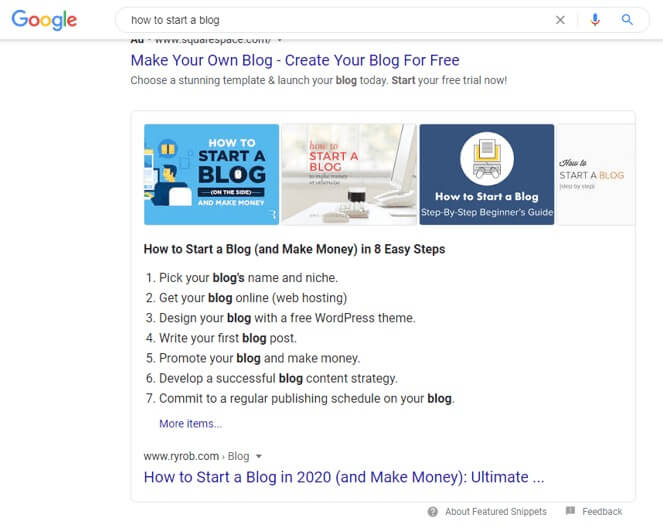
While Google has always held their cards very close to the chest when it comes to advising bloggers & publishers about how to get a rich snippet ranking, I’ve been able to consistently grab rich snippet placements for my content on extremely competitive keyword phrases over the years both on my blog and for clients. It’s pretty straightforward really—grabbing a rich snippet (or featured snippet) placement is just as simple as making sure you’re nailing all of your blog SEO best practices, which includes on-page SEO and working extremely hard to promote your blog content and attract earned links from authoritative websites.
Whew! Alright, I’ve answered a lot of questions—but please keep them coming in the comments below.
Quick Summary of How to Start a Blog in 6 Easy Steps
To sum things up, you need to:
- Pick your blog’s name and niche
- Get your blog online (web hosting)
- Design your blog with a free WordPress theme
- Write your first blog post
- Promote your blog and get readers
- Make money from your blog
C’est ça! Now, if you’re looking for some extra reading to help along on your blogging journey, then here are my greatest hits to read (and bookmark) today:
And if you’re still looking for more, here’s a collection of all my content about blogging.
Will you take the leap today?
Now, I want to know how your blogging journey is coming along too.
Drop me a line or ask any questions in the comments below!
[ad_2]





